:max_bytes(150000):strip_icc():format(webp)/GettyImages-626970032-497800518dac4d6cafa0dc19b953f1ff.jpg)
New 2024 Approved Life After Windows Movie Maker Exploring New Options

Life After Windows Movie Maker: Exploring New Options
Windows Movie Maker has been a cornerstone tool for video editors for quite a while. There are a lot of amateurs who’ve made use of the free program and have done wonders with it. As it is discontinued, many Windows Movie Maker alternatives claim to offer ‘just the right video editing tool for you,’ few can live up to their promises—and most are very expensive.
We have ten other programs that can be used to create videos that include everything from Apple iMovie to other basic alternatives.
So whether you’re a beginner who wants to learn how to make a movie, a pro looking for an excellent alternative to Windows Movie Maker, or someone who wants to make a simple slide presentation or online video, you’re bound to find a video creation program here.
- Wondershare Filmora
- Avidemux Video Editor
- VirtualDub
- Sony Vegas Movie Studio
- WeVideo
- Lightworks
- ShotCut
- OpenShot
- Movavi Video Editor Plus
- VSDC Free Video Editor
- VideoPad Video Editor
- HitFilm
- Magix Movie Studio
- How To Edit a Video With a Windows Movie Maker Alternative
- Hot FAQs on Windows Movie Maker Alternatives
Part 1: Top 3 Picks for Windows Movie Maker Alternatives
The world’s best video editing software is about to change. We look at three of the most popular and valuable alternatives to Windows Movie Maker.
You will need to consider these alternatives to ensure they meet your expectations and needs.
1. Wondershare Filmora - Best Overall

Filmora is the best Windows Movie Maker Alternative designed according to your convenience.
Ratings: 4.4 Stars out 5
Starting from $49.99
2. Magix Movie Studio - Best for Collages

This alternative offers a variety of tools and plugins for anyone who wants to create professional-level videos in under a minute.
Download on Windows
Ratings: 4 stars out of 5
30-day free trials, then starts from $69.99 all the way to $129
3. Avidemux Video Editor - Best Open-Source Editor

An open-source editor that supports a wide range of formats is free! Avidemux has an interface similar to Windows Movie Maker, which makes it a perfect alternative.
Download on Windows
Ratings: 4.0 stars out of 5
Free Trial
Part 2: Ultimate Overview on 13 Best Alternatives to Windows Movie Maker
We live in visual culture, and we constantly see, capture, upload, and share videos on our smartphones, tablets, and laptops. So, it is only natural that more people seek ways to edit their videos. Windows Movie Maker was one of the most popular video editing apps. So it’s time to dig into the best Windows Movie Maker alternatives, which are arguably better and feature-rich.
| Software | OS | Media Resources | AI editing | Easy to Use | Free Trial |
|---|---|---|---|---|---|
| Wondershare Filmora | WindowsMacMobile | Yes | Yes | Yes | Yes |
| Avidemux | WindowsOS XLinuxBSD | Yes | No | Yes | Yes |
| Virtual Dub | Windows | No | No | Yes | Yes |
| Vegas Movie Studio | Windows | Yes | Yes | No | No |
| WeVideo | Online | Yes | No | Yes | Yes |
| Lightworks | LinuxOS X Windows | Yes | Yes | No | No |
| ShotCut | WindowsMacLinuxBSD | Yes | No | No | Yes |
| OpenShot | WindowsMacLinuxChrome OS | Yes | No | Yes | Yes |
| Movavi Plus | WindowsMac | Yes | No | Yes | Yes |
| VSDC | Windows | Yes | No | Yes | Yes |
| VideoPad | WindowsMaciPad/iPhone | Yes | No | Yes | Yes |
| HitFilm | WindowsMac | Yes | Yes | Yes | Yes |
| Magix Movie Studio | Windows | Yes | Yes | No | Yes |
Part 3: 13 Best Windows Movie Maker Alternatives for Windows
As we all know, Windows Movie Maker is the most used and trusted tool for creating videos in Windows. With its unique features and user-friendly interface, people often use this software to develop short and entertaining videos.
However, the fact is that Windows Movie Maker is not the current best video editing software for creating complex video projects. For this reason, we compiled a list of the 12 best alternatives to offer you a better option for Windows Movie Maker.
1. Wondershare Filmora
Filmora 11 is a powerful, easy-to-use video editor specially designed to streamline your workflow and save you hours weekly. It supports everything from Windows, Mac, and IOS to Android. The latest update to the flagship app includes several key enhancements that result in a much more efficient video creation workflow and one that’s easier to use than its rivals.
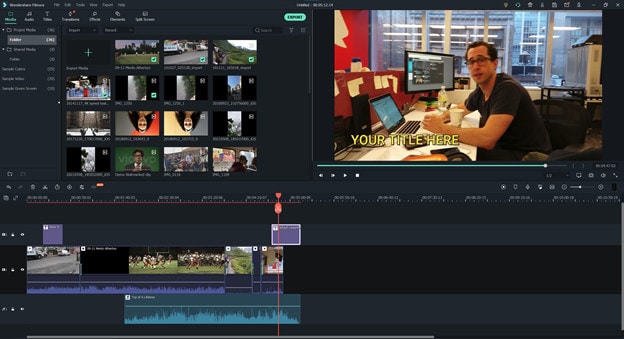
Key features
- Preset Templates
- Instant Mode
- Motion Tracking
- AI Editing Effects
- Auto Synchronization
- Plug-ins
Price
- Annual Plan: $49.99
- Perpetual Plan: $79.99
Pros
- Seamless interface for beginners
- Great customer support
- Plenty of effects and preset templates
- 4K video output options
Cons
- Rendering requires too much time
- The mobile app requires separate subscription
Supported OS: Windows , Mac , iOS , Android , iPad
G2 Ratings: 4.4 stars out of 5
Summary
Filmora’s intuitive interface allows experienced and brand-new users to create incredible videos with flawless special effects. Its high ratings and multiple supported formats make it quite popular among users.
2. Avidemux Video Editor
If you are a beginner and want to use a free, open-source software program for basic video editing, then Avidemux is a good choice. The interface is not as fancy as it could be, but there are some presets that’ll save you a lot of time. Avidemux is a cross-platform video editor that allows you to create custom videos, but it doesn’t feature the ability to share the edited footage to social media directly,
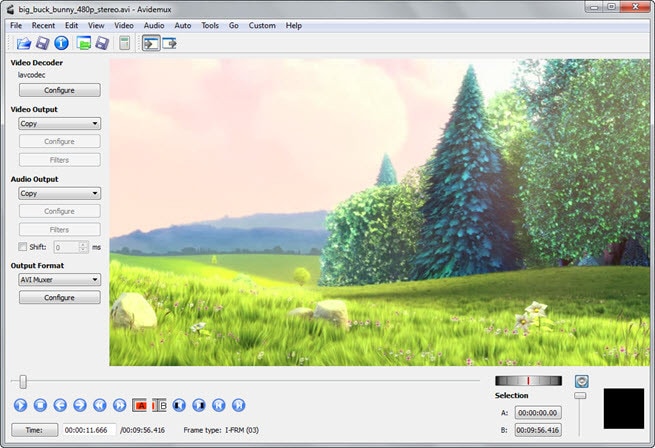
Key features
- Video and Audio Filters
- Support Popular Formats
- Convert Video For Archiving or Publishing
Price: Free
Pros
- It can convert Video To A Smaller Size
- Easy cut, trim, split video
Cons
- Out-dated UI
- Lacks sharing option
Supported OS: Windows , OS X , Linux , BSD
Uptodown Ratings: 4.0 stars out of 5
Summary
An open-source video editor that supports most formats. Due to its obsolete UI and lack of sharing features, Avidemux has average ratings.
3. VirtualDub
This open-source software is user-friendly and allows users with little experience to navigate the software without much trouble. It supports 3rd party apps and also offers batch-processing, which means working on multiple videos simultaneously makes it possible.
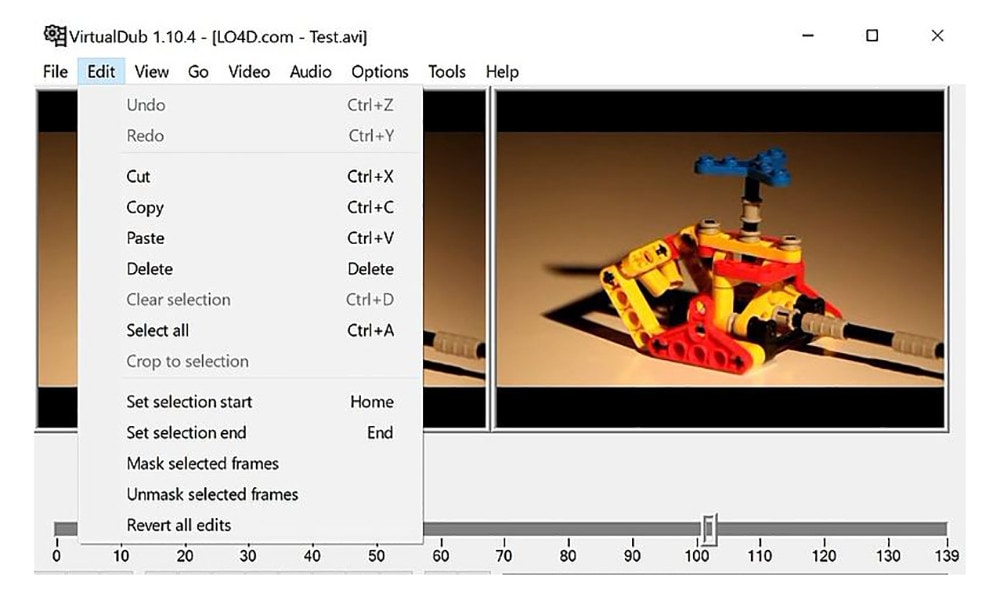
Key features
- Integrated volume and histogram meter
- Optimized disk
- Noise reduction
- Fractional frame rates
Price: Free
Pros
- Clean interface, easy to use
- Keyboard and mouse shortcuts for faster operation
- Free to use
Cons
- Not suitable for 4K editing
- Lack learning material
- Obsolete Interface
Supported OS: Windows
Compare Camp Ratings: 4.0 stars out of 5
Summary
Virtual Dub supports multitasking, and its features are pretty helpful. However, it lacks 4k editing and a friendly interface. Overall Virtual Dub is a good choice.
4. Sony Vegas Movie Studio
This video editing software makes it easy to create professional-looking videos in minimum time and effort. Vegas Movie Studio software is best for video editing professionals who have been doing it for some time and are looking for something a little more sophisticated than free alternatives. Not only does it has a high retail price, but its internal elements can be too complex for those just beginning.
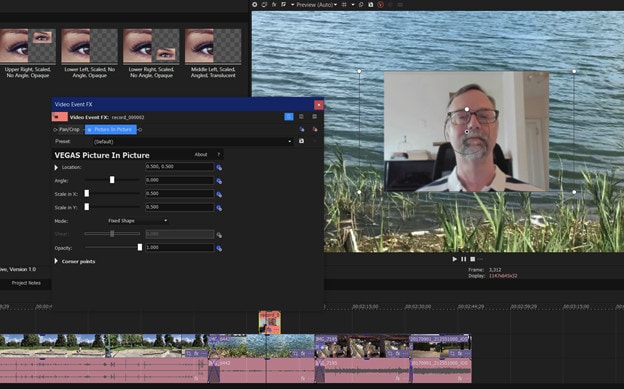
Key features
- Color correction
- HDV and AVCHD-editing
- DV batch capture
- Wide variety of file formats and codecs
Price: Starting from $7.99 USD per month
Pros
- Customizable interface
- Multicam editing
- Lots of effects and transitions, with plug-in capability
- Good slow motion and warp flow transition tools
Cons
- Less intuitive interface than competitors
- Import from camcorder not ideal
- Some tools are complex
Supported OS: Windows
G2 Ratings: 4.4 out of 5
Summary
Vegas Movie Studio is the choice of professionals. It does all the work without taking up a lot of resources, and like most programs, there is a learning curve. It’s not always intuitive for beginners, but its professional and powerful features score decent in most reviews.
5. WeVideo
This cloud-based application is a simple-to-use video editing and sharing suite. WeVideo is a full-featured video editing application that uses JumpStart technology to create amazing videos. It’s an innovative app that offers a seamless editing experience as it supports multiple formats of video, images, audio, and graphics.
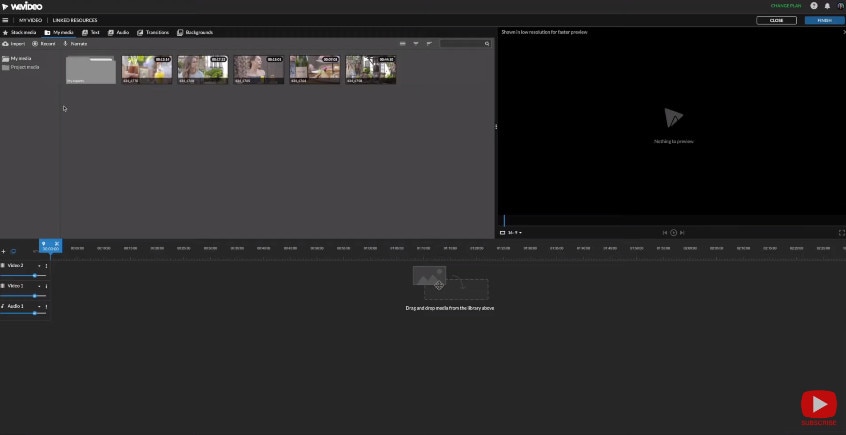
Key features
- WeVideo JumpStart
- Cloud storage
- Built-in graphics
- Customizable environment
- Advanced text editing
- Multi-track editing and storyboard
Price
- Free trial
- Power Plan: $9.99/month
- Unlimited Plan: $15.99/month
- Professional Plan: $39.99/month
- Business Plan: $73.99/month
Pros
- Constantly improving features
- Ease of use
- Storage is cloud-based
Cons
- Old fashion transition
- Leaves a watermark on free trial
Supported OS: Online
Trustpilot Ratings: 4 stars out of 5
Summary
WeVideo is a straightforward yet robust video editor. It offers a variety of features and supports multiple formats, plus its comprehensive pricing plan makes it useful for everyone.
6. Lightworks
Lightworks is the most powerful video editor in its class and an excellent tool for professionals who want to make amazing videos quickly. Lightworks is very fast and straightforward to use, and it has some great features you won’t find in any other video editor. It is available on all popular OS.
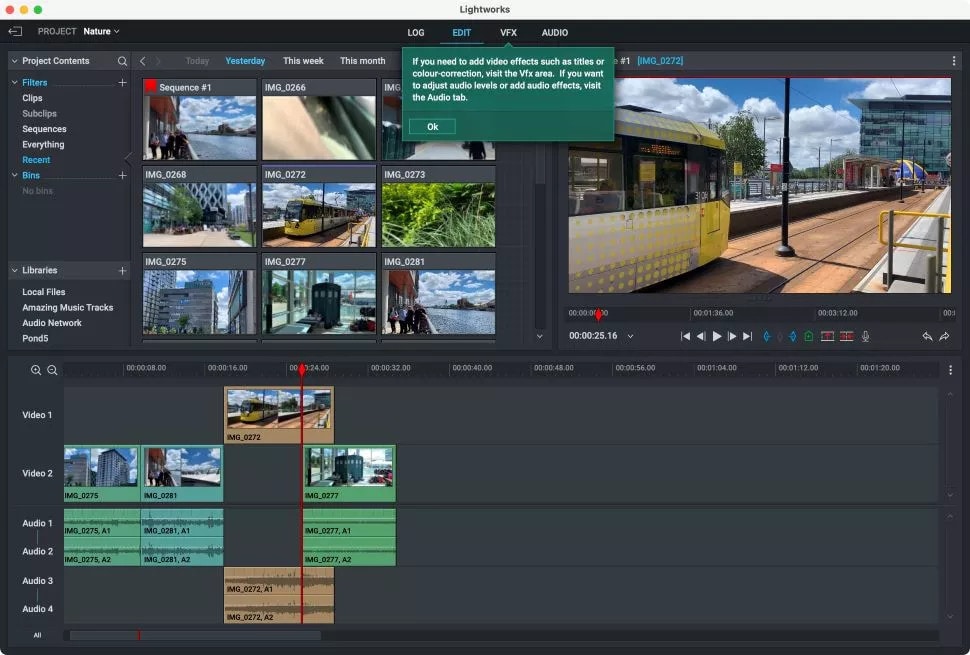
Key features
- Audio and Video Effect Plugin Support
- Cloud Connected
- Motion Graphics
- Advanced Metadata
- Proxy Workflows
- Apple ProRes decoding
Price
- Monthly Plan: $9.99/user
- Yearly Plan: $9.99/user
- Perpetual: $154.99
Pros
- High-resolution timeline rendering
- It has social media export templates
- Interfaces for multiple OS are consistent
- Instant autosave
Cons
- Commands are not always intuitive
- A bit pricey as compared to its competitors
Supported OS: Windows , Mac , Linux
Techradar Pro Ratings: 4 stars out of 5
Summary
Lightworks is not any other video editing tool available on the market of video editing tools. This video editing tool provides amateurs with the most sophisticated features in an optimized platform. Its scores are the highest on almost every review site.
7. ShotCut
Shotcut is a multiplatform video editor that lets you work with various formats for audio, video, image files, etc. This video editor makes it easy to mix and match the resolution and frame rates in a video file. All the changes you make in the editor can be undone and redone often. Shotcut is the best choice for video editing, without question.

Key features
- Webcam capture
- Audio scopes and filters
- Deinterlacing
- Eyedropper tool
- Video wipe transitions
- Keyframes for filter parameters
Price: Free
Pros
- Support for 4K resolutions
- Free
Cons
- Less intuitive than commercial apps
- Lacks built-in sharing to popular sites
Supported OS: Windows , Mac , Linux
GetApp Ratings: 4.5 out of 5 stars
Summary
Shotcut is an open-source video editor for creative professionals and is available on mac, Windows, and Linux. The free version of Shotcut has many excellent features, but it doesn’t have the slick interface or advanced techniques of the top paid editors.
8. OpenShot
An award-winning open-source video editor that creates stunning videos. OpenShot is a fast, easy-to-use, and surprisingly powerful video editor. OpenShot Video Editor allows you to work with many different types of tracks so that your edits will seem natural. OpenShot Video Editor allows you to add your custom animations or titles. The options are endless, so it all depends on your time and interest. It is available in more than 70 languages, making it ideal for all types of users.
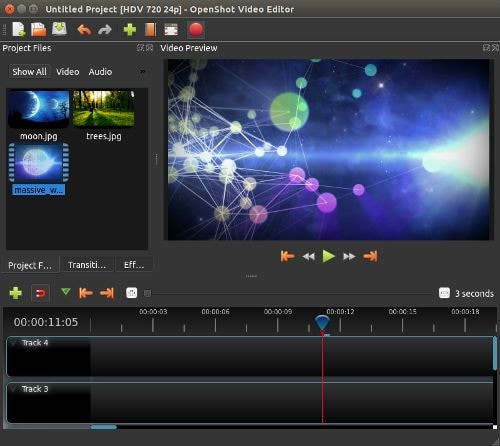
Key features
- 3D animations
- Animation and keyframes
- Multiple languages and formats
- Cross-platform
- Video-effects
Price: Free
Pros
- It is a non-linear editor with infinite tracks
- 100% free without watermark
- Frequent updates
Cons
- Obsolete interface
- Unstable performance
- Lacks some editing features
Supported OS: Window , Mac , Linux , Chrome OS
Getapp Ratings: 4.2 stars out of 5
Summary
Another open-source video-editor in the list is named OpenShot. It’s a multi-lingual and multi-supported app with unique features. Despite its unstable performance, OpenShot is still an ideal choice for many users.
9. Movavi Video Editor Plus
Movavi Video Editor Plus is the perfect tool to bring your creative ideas to life. It has special effects, ready-made intros, and keyframe animation. Using chroma keying, you can change the background of your video clips to any color or pattern that suits your need. Movavi has now redesigned its user interface to make it easy to use.
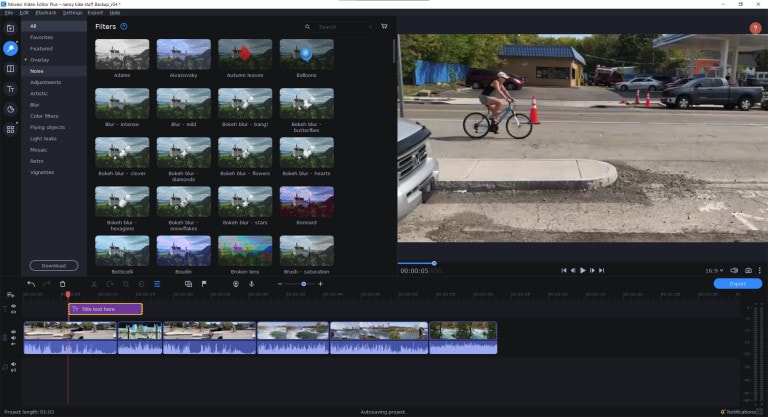
Key features
- Effects and transitions
- Built-in media pack
- Fast processing of 4K videos
- Keyframe animation
- Automatic video creation
- Cutting, trimming, joining
Price
- Free version: 7 days
- Video Editor Plus 1 year /1 PC: $49.95
- Video Editor Plus Lifetime /1 PC: $69.95
- Video Suite Lifetime /1 PC: $89.95
Pros
- Easy-to-understand user interface
- Transitions with sound
- Motion tracking and picture-in-picture tools
- Chroma-key capability
- Quick movie-creation tool
Cons
- Lacks advanced trim modes
- Slow rendering
PCMag Ratings: 4.0 stars out of 5
Summary
If you want to edit your videos with a minimal learning curve, try Movavi. You get PiP, chroma-keying, titling, basic keying, and motion tracking. The program is simple to use but doesn’t have all the features and stands four stars.
10. VSDC Free Video Editor
VSDC Free Video Editor is an online tool that lets you edit audio and video files to make your creations like movies, YouTube tutorial videos, and more. The audio and video files supported are extensive, and the software includes a codec manager. The Pro version isn’t necessary if you’re using the free edition of the software; it’s more than enough to get the job done.
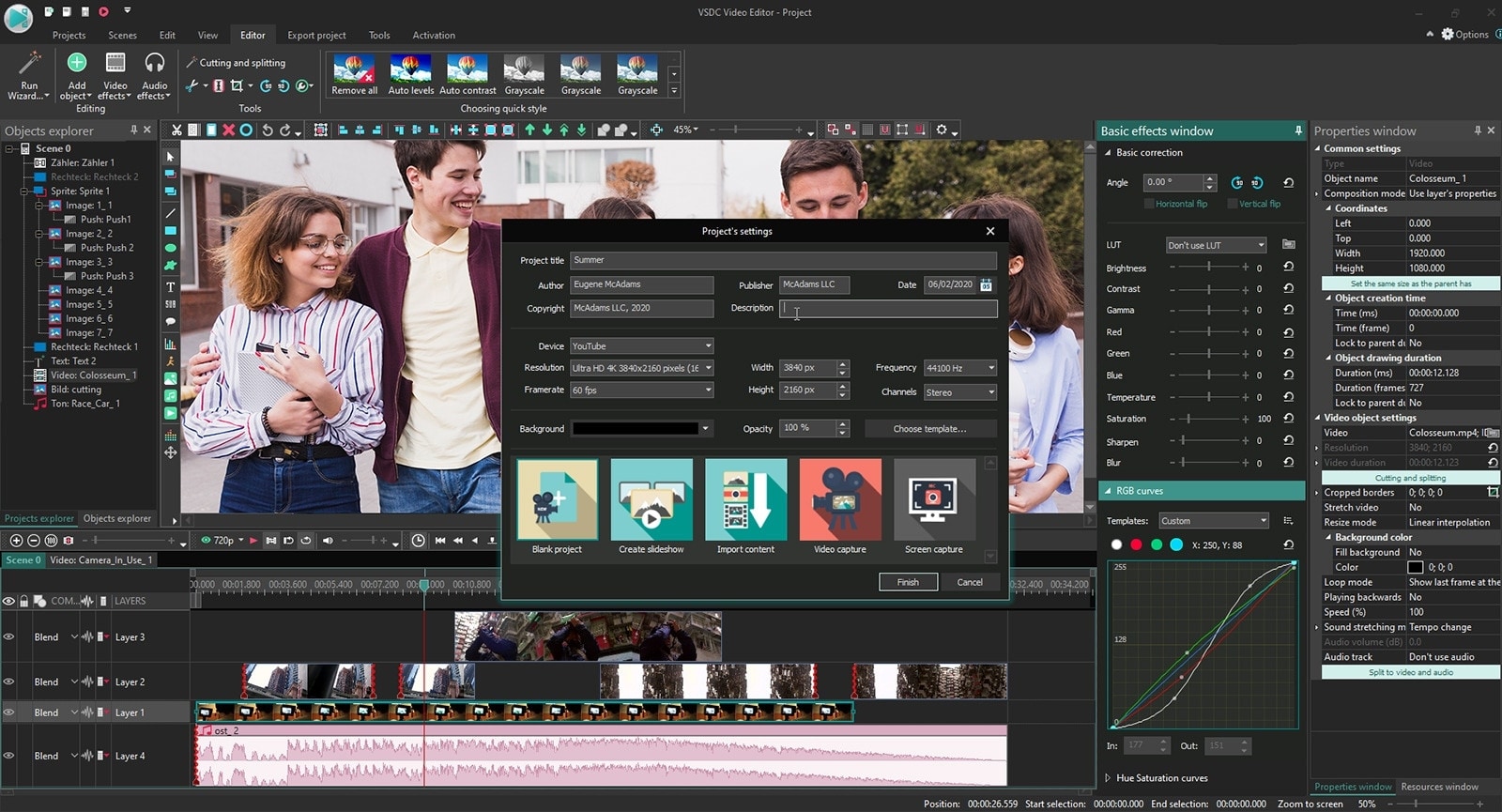
Key features
- Dark theme
- Subpixel Accuracy
- Powerful Chroma Key tool
- Trendy video effects, filters, and transitions
- Color Blending And Filters
- Built-In DVD Burning Tool
Price: Free
Pros
- Non-linear
- Video effects library
- Video stabilization
- Masking
Cons
- Outdated interface
- Lack keyboard shortcuts
- Only available on Windows
Supported OS: Windows
Capterra Ratings: 4.5 stars out 5
Summary
VSDC is a non-linear editor with extensive format support. It includes all the essential features an editor requires but with an obsolete UI. It is also ideal for many who need a powerful yet free video editor.
11. VideoPad Video Editor
VideoPad is a free video editor that can create stunning videos and perform basic editing tasks. A good video editor can help you to create videos for different social media platforms. You can make your videos look professional and polished with a few clicks and some simple editing skills. There’s nothing particularly exciting or advanced about this app; it’s simple enough for anyone new to video editing or even for seasoned editors. But the simple and easy-to-use interface makes the entire process very exciting.
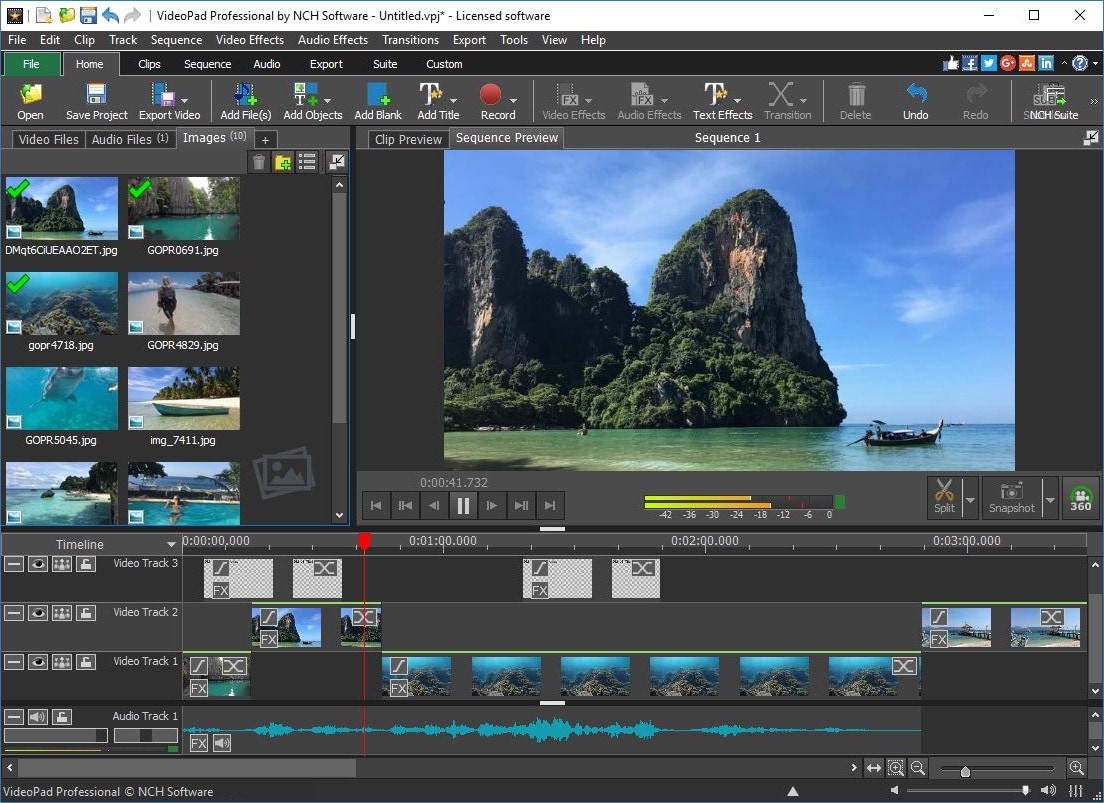
Key features
- Text snippets
- Range of transitional effects
- Plug-ins Library
- Burn finished videos to Blu-Ray, DVD, etc.
- Color correction and light balance.
Price: Free
Pros
- Simple and clean interface
- Supports multiple file formats
- Includes video effects
- Lightweight on system resources
Cons
- Lack of advanced features
Supported OS: Windows , Mac , iPad/iPhone
Tom’s guide Ratings: 3.5 stars out of 5
Summary
Video pad is a free video editor designed for beginners that is lightweight and simple. VideoPad is also great for creating quick videos for social media purposes like Youtube and Facebook. The software has a high rating, as shown above, and it’s available on Windows.
12. HitFilm
HitFilm is a helpful video editing software that makes editing easier for users. In addition to basic features, the program also provides advanced-level functions that make edited videos pop. Hitfilm Express Download has more than 400 features to help casual video editors save time. Features like: visual effects, cinematic elements, and compositing tools preset help unleash your creativity.
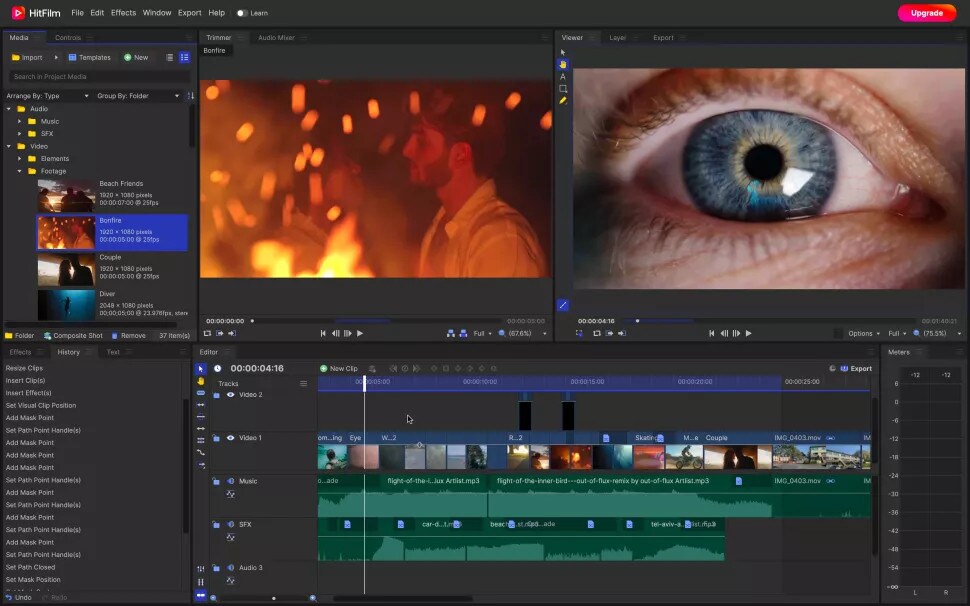
Key features
- Color Grading and correction
- Smart search
- Commentator recorder
- Lightning and lens flares
- 3D camera tracker
Price
- Free trial
- Creator: $7.50
- Pro: $12.50
- Enterprise: Custom pricing
Pros
- Intuitive interface
- It offers free tutorials and masterclasses
- Works on both Windows and Mac
Cons
- It requires heavy system requirements
TechRadar Ratings: 4.5 stars out of 5
Summary
HitFilm Express 15 is a powerful free video editing program that enables you to create high-quality videos in minutes with an intuitive interface. It offers advanced editing features such as advanced video trimming, 3D editing, and more.
13. Magix Movie Studio
Magix is the world’s leading professional audiovisual media software, with Sequoia being its industry-standard audio editing software. This movie editor is an enthusiast-level video editing software that competes with software from Adobe and CyberLink, and it even boasts support for 4K content and 360 degrees. There are many reasons to upgrade. This year’s update includes stabilization, 8K editing, motion tracking, and an in-app plug-in store.
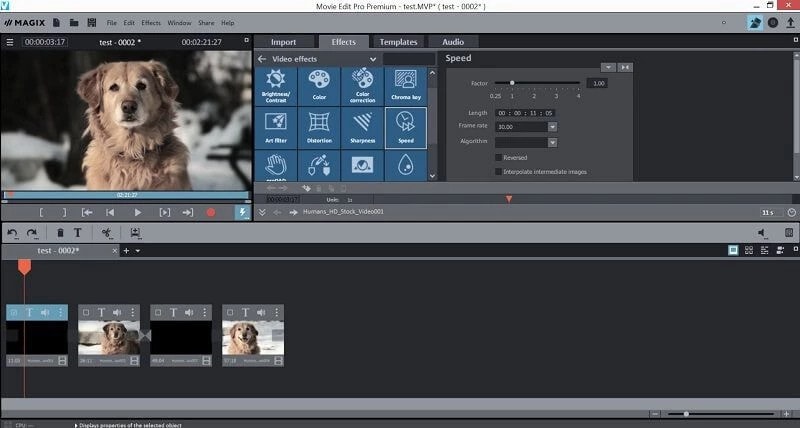
Key features
- NewBlue effects
- Fly-in animation
- New filter view
- Stabilization
- Motion tracking
- 8k support
Price
- Movie Studio 2024: $69.99 (30-day free trial)
- Movie Studio 2024 Platinum: $99.99 (30-day free trial)
- Movie Studio 2024 Suite: $129.00 (30-day free trial)
Pros
- Lots of video effects
- Responsive editing interface
- Multicam
- Trailer-like movie templates
- Solid audio editing
Cons
- Slower project rendering than others
- Lacks import and organization tools
Supported OS: Windows
PCMag Ratings: 3 stars out of 5
Summary
Magix movie studio is a powerful all-around video editing tool with many features that professional users have come to expect. It’s also relatively simple to use. But usability and performance are poor compared to other software programs like Filmora .
Part 4: How To Edit a Video With a Windows Movie Maker Alternative
Windows Movie Maker was great for editing a video, but it’s no match for some of the best video editing software. We’re talking about software capable of creating a cinematic experience in seconds, all on your computer.
When you need to edit a video with simple, quick edits, like adding a special effect or changing the background, try Filmora . Filmora is an easy-to-use application that allows you to create a movie using simple tools that don’t require additional training. You can’t beat this option if you want to create a professional-quality video for your blog or website.
Let’s dive into a quick tutorial on editing videos in Filmora:
Free Download For Win 7 or later(64-bit)
Free Download For macOS 10.14 or later
Step1 Open Wondershare Filmora on your PC or Mac
You can start a new project by clicking on ‘New Project’. And you can also change the ‘Aspect Ratio’ according to your project demand.

Step2 Import Videos
You can import your file by clicking the import tab on the upper-left side or clicking the import icon on the main window.
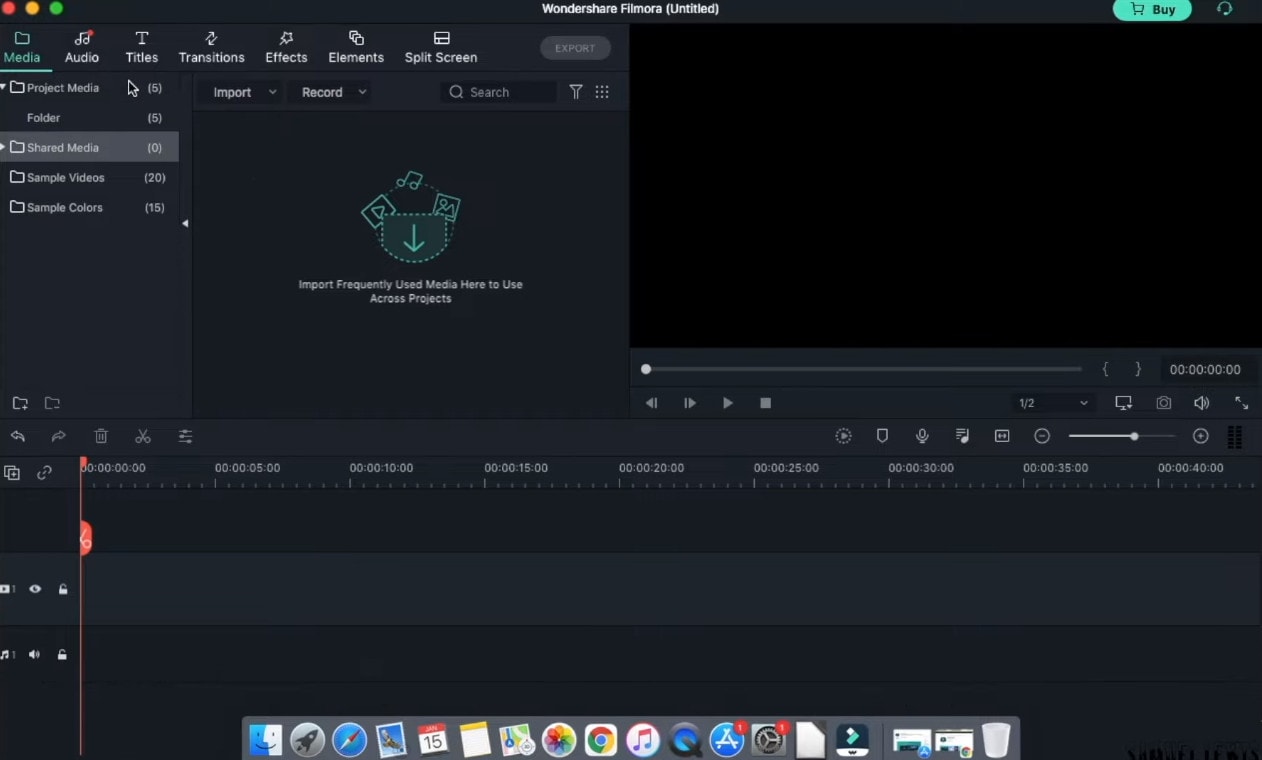
Step3 Drag and drop your footage to the timeline
After importing all the files, click and hold each individual video and drag and drop it to the timeline area according to your ideal sequence.
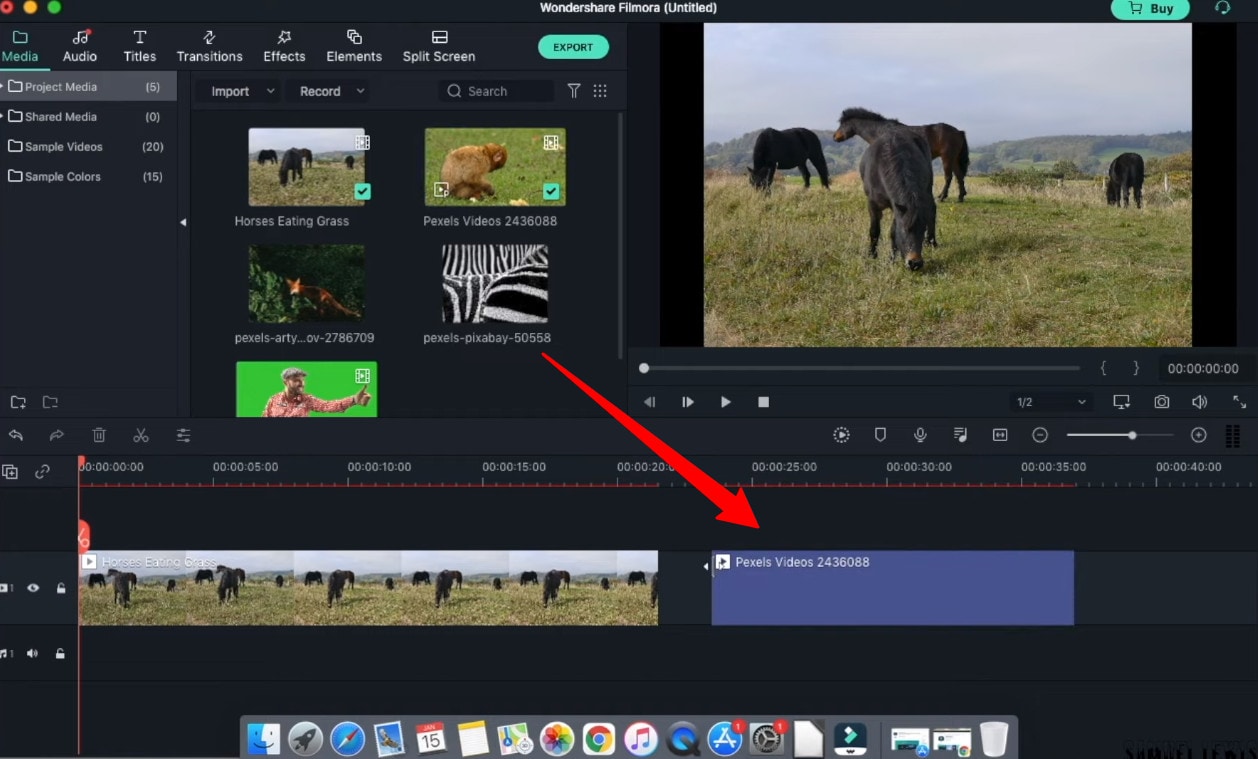
Step4 Add Audio
Go to the ‘Audio’ tab and select the audio file from the audio library. Once selected, drag and drop the audio file into the music timeline.
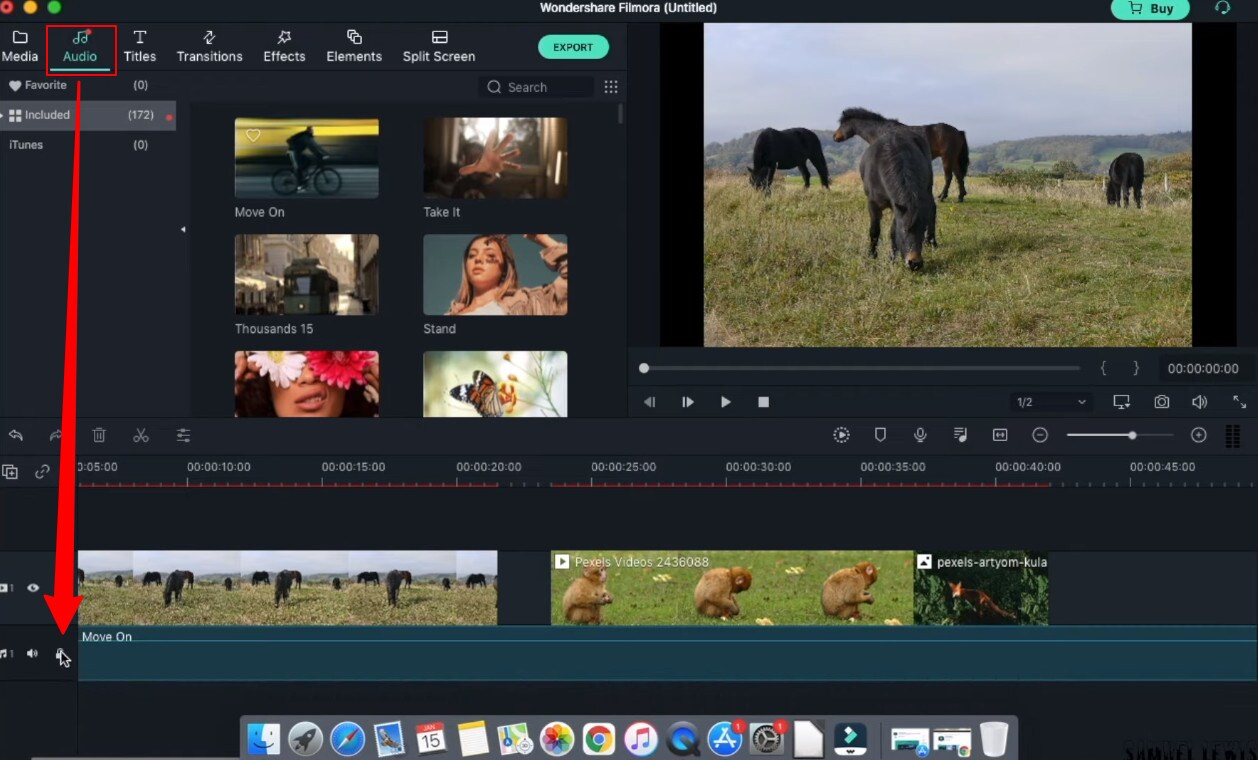
Step5 Add Titles
In your video intro, you can insert some title text. Go to the ‘Titles’ tab and select the one you like, and drag and drop it on top of the timeline. Double-click and edit the text and state your ideal statements. You can customize your text fonts and color too.
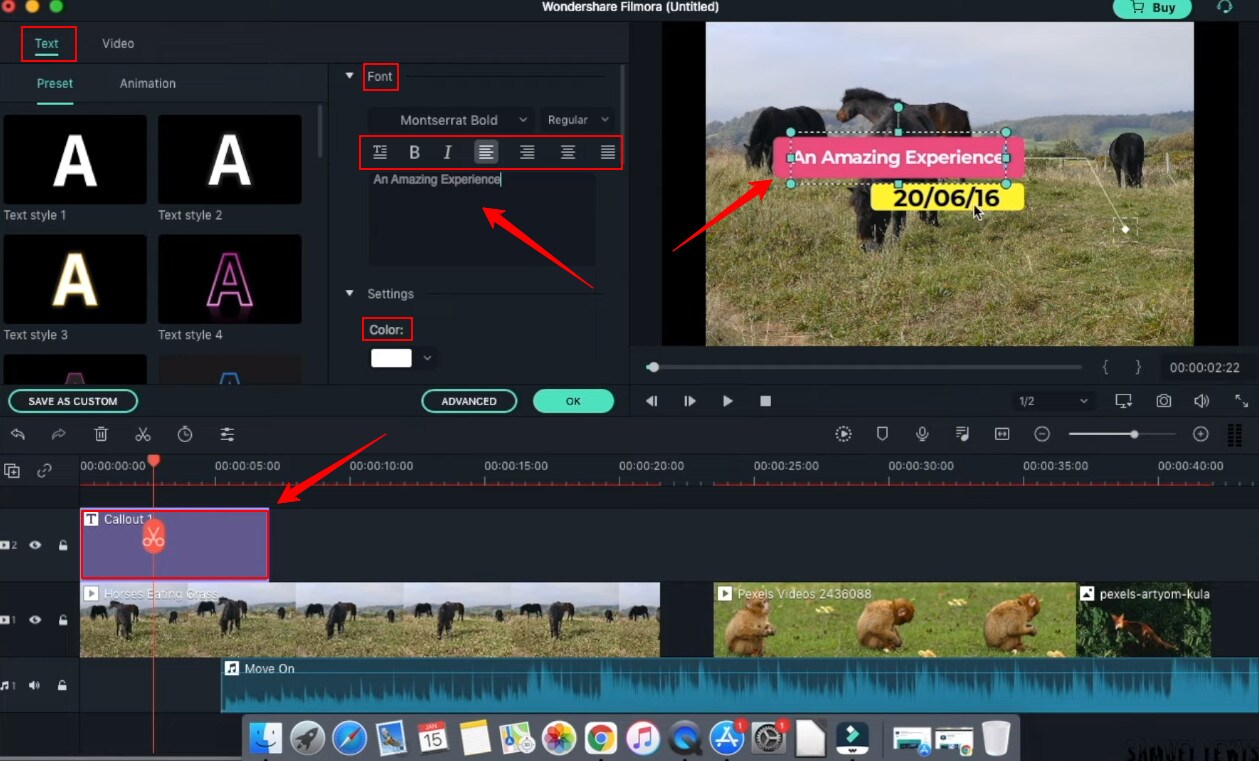
Step6 Add Transitions
You can add transition effects to ensure a smooth transition from one scene to another. The overall will get more professional look.

Step7 Add Effects
Next; you can get special effects to your video to make them more attractive and engaging to watch. Simple drag down the effect to your video and watch the effect take place in your selective scene.
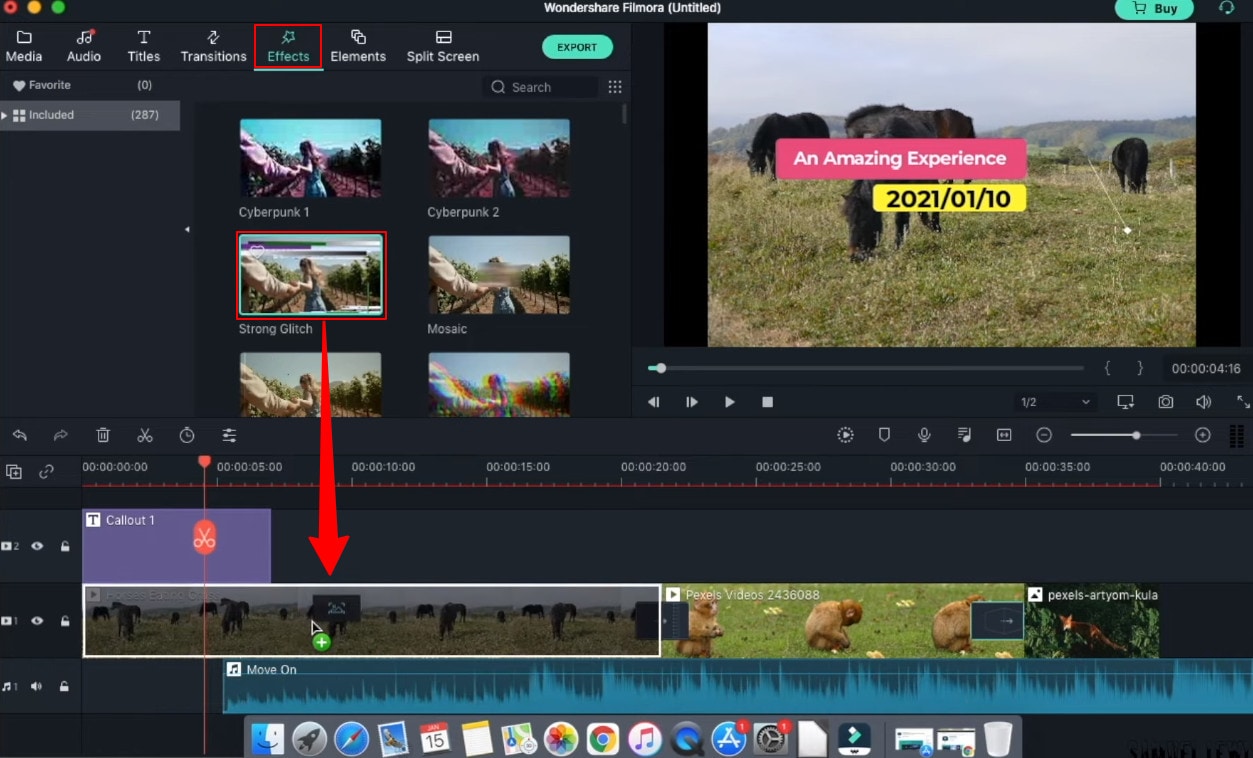
Step8 Export your work
Once all the changes have been made, hit ‘export’ from the top tab. A window will appear where you can change the settings, resolution, frame rate, bit rate, etc. Next, click the ‘export’ button down on that window, and then you can save the file in your drive.
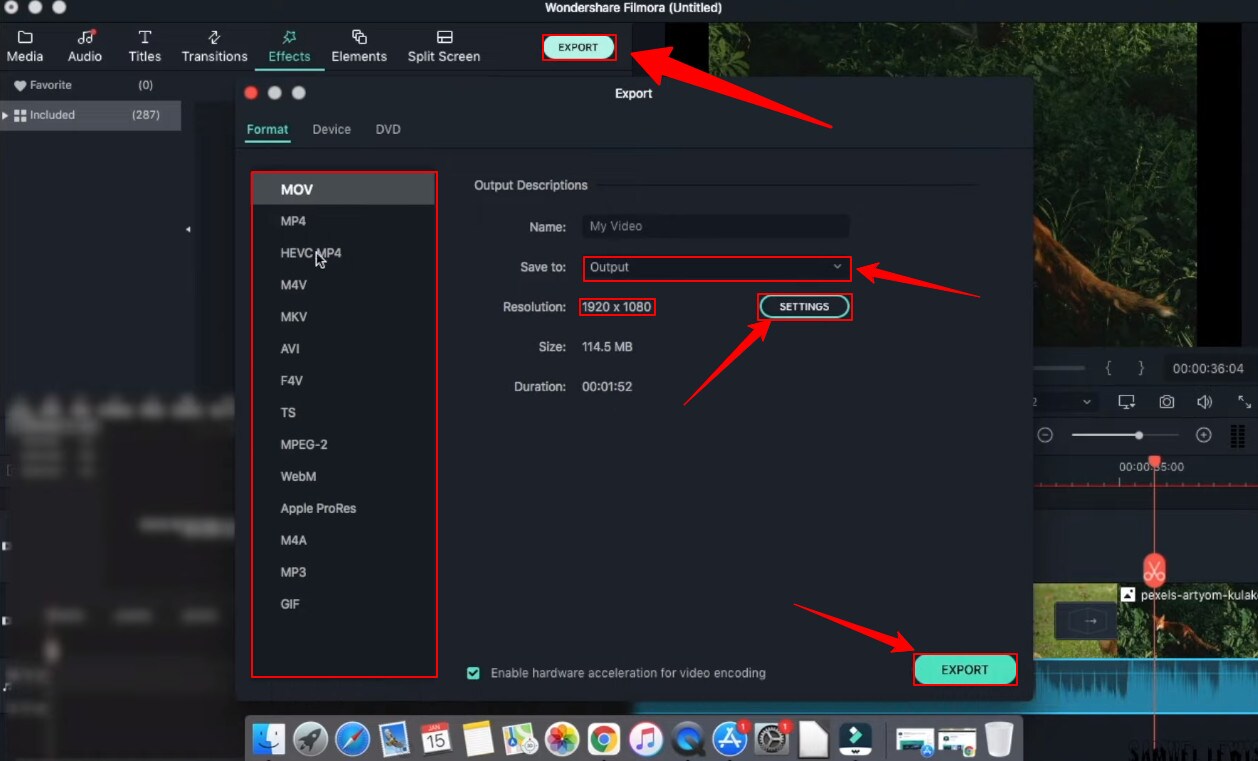
Part 5: Hot FAQs on Windows Movie Maker Alternatives
1. Why is Windows Movie Maker discontinued?
Microsoft’s video editing program, Windows Movie Maker, did not become a big hit with the public because it failed to do well on the market. Microsoft couldn’t get the support they were looking for from the program’s users. As a result, Microsoft had to cease its support of the program.
2. Is there a free version of Windows Movie Maker?
Microsoft Windows Movie maker was always accessible and pre-installed every windows product. Microsoft has discontinued support for Movie Maker and warns about free downloads of Movie Maker provided by third parties that might contain malware, viruses, or other issues.
3. What are the best free Windows Movie Maker Alternatives for Mac?
After switching to a Mac, you’ll find that the Windows Movie Maker alternatives offer much more than just a simple video editor. They provide advanced features, easy transitions, and less technical know-how to create pro-quality results. You should try using these platforms on your Mac if you have a video to edit.
- Wondershare Filmora
- Movavi
- OpenShot
Final Words
Windows Movie Maker is an excellent Windows video editor application for Windows users. But in recent years, it has become outdated due to the continuous development of new technologies. There are many alternatives for Windows Movie Maker, and here we listed some of the best ones. Most of them are free and featured packs. Each program has its unique set of features and capabilities, and each one excels in different areas. Check them out and see what you think.
Free Download For Win 7 or later(64-bit)
Free Download For macOS 10.14 or later
Part 1: Top 3 Picks for Windows Movie Maker Alternatives
The world’s best video editing software is about to change. We look at three of the most popular and valuable alternatives to Windows Movie Maker.
You will need to consider these alternatives to ensure they meet your expectations and needs.
1. Wondershare Filmora - Best Overall

Filmora is the best Windows Movie Maker Alternative designed according to your convenience.
Ratings: 4.4 Stars out 5
Starting from $49.99
2. Magix Movie Studio - Best for Collages

This alternative offers a variety of tools and plugins for anyone who wants to create professional-level videos in under a minute.
Download on Windows
Ratings: 4 stars out of 5
30-day free trials, then starts from $69.99 all the way to $129
3. Avidemux Video Editor - Best Open-Source Editor

An open-source editor that supports a wide range of formats is free! Avidemux has an interface similar to Windows Movie Maker, which makes it a perfect alternative.
Download on Windows
Ratings: 4.0 stars out of 5
Free Trial
Part 2: Ultimate Overview on 13 Best Alternatives to Windows Movie Maker
We live in visual culture, and we constantly see, capture, upload, and share videos on our smartphones, tablets, and laptops. So, it is only natural that more people seek ways to edit their videos. Windows Movie Maker was one of the most popular video editing apps. So it’s time to dig into the best Windows Movie Maker alternatives, which are arguably better and feature-rich.
| Software | OS | Media Resources | AI editing | Easy to Use | Free Trial |
|---|---|---|---|---|---|
| Wondershare Filmora | WindowsMacMobile | Yes | Yes | Yes | Yes |
| Avidemux | WindowsOS XLinuxBSD | Yes | No | Yes | Yes |
| Virtual Dub | Windows | No | No | Yes | Yes |
| Vegas Movie Studio | Windows | Yes | Yes | No | No |
| WeVideo | Online | Yes | No | Yes | Yes |
| Lightworks | LinuxOS X Windows | Yes | Yes | No | No |
| ShotCut | WindowsMacLinuxBSD | Yes | No | No | Yes |
| OpenShot | WindowsMacLinuxChrome OS | Yes | No | Yes | Yes |
| Movavi Plus | WindowsMac | Yes | No | Yes | Yes |
| VSDC | Windows | Yes | No | Yes | Yes |
| VideoPad | WindowsMaciPad/iPhone | Yes | No | Yes | Yes |
| HitFilm | WindowsMac | Yes | Yes | Yes | Yes |
| Magix Movie Studio | Windows | Yes | Yes | No | Yes |
Part 3: 13 Best Windows Movie Maker Alternatives for Windows
As we all know, Windows Movie Maker is the most used and trusted tool for creating videos in Windows. With its unique features and user-friendly interface, people often use this software to develop short and entertaining videos.
However, the fact is that Windows Movie Maker is not the current best video editing software for creating complex video projects. For this reason, we compiled a list of the 12 best alternatives to offer you a better option for Windows Movie Maker.
1. Wondershare Filmora
Filmora 11 is a powerful, easy-to-use video editor specially designed to streamline your workflow and save you hours weekly. It supports everything from Windows, Mac, and IOS to Android. The latest update to the flagship app includes several key enhancements that result in a much more efficient video creation workflow and one that’s easier to use than its rivals.

Key features
- Preset Templates
- Instant Mode
- Motion Tracking
- AI Editing Effects
- Auto Synchronization
- Plug-ins
Price
- Annual Plan: $49.99
- Perpetual Plan: $79.99
Pros
- Seamless interface for beginners
- Great customer support
- Plenty of effects and preset templates
- 4K video output options
Cons
- Rendering requires too much time
- The mobile app requires separate subscription
Supported OS: Windows , Mac , iOS , Android , iPad
G2 Ratings: 4.4 stars out of 5
Summary
Filmora’s intuitive interface allows experienced and brand-new users to create incredible videos with flawless special effects. Its high ratings and multiple supported formats make it quite popular among users.
2. Avidemux Video Editor
If you are a beginner and want to use a free, open-source software program for basic video editing, then Avidemux is a good choice. The interface is not as fancy as it could be, but there are some presets that’ll save you a lot of time. Avidemux is a cross-platform video editor that allows you to create custom videos, but it doesn’t feature the ability to share the edited footage to social media directly,

Key features
- Video and Audio Filters
- Support Popular Formats
- Convert Video For Archiving or Publishing
Price: Free
Pros
- It can convert Video To A Smaller Size
- Easy cut, trim, split video
Cons
- Out-dated UI
- Lacks sharing option
Supported OS: Windows , OS X , Linux , BSD
Uptodown Ratings: 4.0 stars out of 5
Summary
An open-source video editor that supports most formats. Due to its obsolete UI and lack of sharing features, Avidemux has average ratings.
3. VirtualDub
This open-source software is user-friendly and allows users with little experience to navigate the software without much trouble. It supports 3rd party apps and also offers batch-processing, which means working on multiple videos simultaneously makes it possible.

Key features
- Integrated volume and histogram meter
- Optimized disk
- Noise reduction
- Fractional frame rates
Price: Free
Pros
- Clean interface, easy to use
- Keyboard and mouse shortcuts for faster operation
- Free to use
Cons
- Not suitable for 4K editing
- Lack learning material
- Obsolete Interface
Supported OS: Windows
Compare Camp Ratings: 4.0 stars out of 5
Summary
Virtual Dub supports multitasking, and its features are pretty helpful. However, it lacks 4k editing and a friendly interface. Overall Virtual Dub is a good choice.
4. Sony Vegas Movie Studio
This video editing software makes it easy to create professional-looking videos in minimum time and effort. Vegas Movie Studio software is best for video editing professionals who have been doing it for some time and are looking for something a little more sophisticated than free alternatives. Not only does it has a high retail price, but its internal elements can be too complex for those just beginning.

Key features
- Color correction
- HDV and AVCHD-editing
- DV batch capture
- Wide variety of file formats and codecs
Price: Starting from $7.99 USD per month
Pros
- Customizable interface
- Multicam editing
- Lots of effects and transitions, with plug-in capability
- Good slow motion and warp flow transition tools
Cons
- Less intuitive interface than competitors
- Import from camcorder not ideal
- Some tools are complex
Supported OS: Windows
G2 Ratings: 4.4 out of 5
Summary
Vegas Movie Studio is the choice of professionals. It does all the work without taking up a lot of resources, and like most programs, there is a learning curve. It’s not always intuitive for beginners, but its professional and powerful features score decent in most reviews.
5. WeVideo
This cloud-based application is a simple-to-use video editing and sharing suite. WeVideo is a full-featured video editing application that uses JumpStart technology to create amazing videos. It’s an innovative app that offers a seamless editing experience as it supports multiple formats of video, images, audio, and graphics.

Key features
- WeVideo JumpStart
- Cloud storage
- Built-in graphics
- Customizable environment
- Advanced text editing
- Multi-track editing and storyboard
Price
- Free trial
- Power Plan: $9.99/month
- Unlimited Plan: $15.99/month
- Professional Plan: $39.99/month
- Business Plan: $73.99/month
Pros
- Constantly improving features
- Ease of use
- Storage is cloud-based
Cons
- Old fashion transition
- Leaves a watermark on free trial
Supported OS: Online
Trustpilot Ratings: 4 stars out of 5
Summary
WeVideo is a straightforward yet robust video editor. It offers a variety of features and supports multiple formats, plus its comprehensive pricing plan makes it useful for everyone.
6. Lightworks
Lightworks is the most powerful video editor in its class and an excellent tool for professionals who want to make amazing videos quickly. Lightworks is very fast and straightforward to use, and it has some great features you won’t find in any other video editor. It is available on all popular OS.

Key features
- Audio and Video Effect Plugin Support
- Cloud Connected
- Motion Graphics
- Advanced Metadata
- Proxy Workflows
- Apple ProRes decoding
Price
- Monthly Plan: $9.99/user
- Yearly Plan: $9.99/user
- Perpetual: $154.99
Pros
- High-resolution timeline rendering
- It has social media export templates
- Interfaces for multiple OS are consistent
- Instant autosave
Cons
- Commands are not always intuitive
- A bit pricey as compared to its competitors
Supported OS: Windows , Mac , Linux
Techradar Pro Ratings: 4 stars out of 5
Summary
Lightworks is not any other video editing tool available on the market of video editing tools. This video editing tool provides amateurs with the most sophisticated features in an optimized platform. Its scores are the highest on almost every review site.
7. ShotCut
Shotcut is a multiplatform video editor that lets you work with various formats for audio, video, image files, etc. This video editor makes it easy to mix and match the resolution and frame rates in a video file. All the changes you make in the editor can be undone and redone often. Shotcut is the best choice for video editing, without question.

Key features
- Webcam capture
- Audio scopes and filters
- Deinterlacing
- Eyedropper tool
- Video wipe transitions
- Keyframes for filter parameters
Price: Free
Pros
- Support for 4K resolutions
- Free
Cons
- Less intuitive than commercial apps
- Lacks built-in sharing to popular sites
Supported OS: Windows , Mac , Linux
GetApp Ratings: 4.5 out of 5 stars
Summary
Shotcut is an open-source video editor for creative professionals and is available on mac, Windows, and Linux. The free version of Shotcut has many excellent features, but it doesn’t have the slick interface or advanced techniques of the top paid editors.
8. OpenShot
An award-winning open-source video editor that creates stunning videos. OpenShot is a fast, easy-to-use, and surprisingly powerful video editor. OpenShot Video Editor allows you to work with many different types of tracks so that your edits will seem natural. OpenShot Video Editor allows you to add your custom animations or titles. The options are endless, so it all depends on your time and interest. It is available in more than 70 languages, making it ideal for all types of users.

Key features
- 3D animations
- Animation and keyframes
- Multiple languages and formats
- Cross-platform
- Video-effects
Price: Free
Pros
- It is a non-linear editor with infinite tracks
- 100% free without watermark
- Frequent updates
Cons
- Obsolete interface
- Unstable performance
- Lacks some editing features
Supported OS: Window , Mac , Linux , Chrome OS
Getapp Ratings: 4.2 stars out of 5
Summary
Another open-source video-editor in the list is named OpenShot. It’s a multi-lingual and multi-supported app with unique features. Despite its unstable performance, OpenShot is still an ideal choice for many users.
9. Movavi Video Editor Plus
Movavi Video Editor Plus is the perfect tool to bring your creative ideas to life. It has special effects, ready-made intros, and keyframe animation. Using chroma keying, you can change the background of your video clips to any color or pattern that suits your need. Movavi has now redesigned its user interface to make it easy to use.

Key features
- Effects and transitions
- Built-in media pack
- Fast processing of 4K videos
- Keyframe animation
- Automatic video creation
- Cutting, trimming, joining
Price
- Free version: 7 days
- Video Editor Plus 1 year /1 PC: $49.95
- Video Editor Plus Lifetime /1 PC: $69.95
- Video Suite Lifetime /1 PC: $89.95
Pros
- Easy-to-understand user interface
- Transitions with sound
- Motion tracking and picture-in-picture tools
- Chroma-key capability
- Quick movie-creation tool
Cons
- Lacks advanced trim modes
- Slow rendering
PCMag Ratings: 4.0 stars out of 5
Summary
If you want to edit your videos with a minimal learning curve, try Movavi. You get PiP, chroma-keying, titling, basic keying, and motion tracking. The program is simple to use but doesn’t have all the features and stands four stars.
10. VSDC Free Video Editor
VSDC Free Video Editor is an online tool that lets you edit audio and video files to make your creations like movies, YouTube tutorial videos, and more. The audio and video files supported are extensive, and the software includes a codec manager. The Pro version isn’t necessary if you’re using the free edition of the software; it’s more than enough to get the job done.

Key features
- Dark theme
- Subpixel Accuracy
- Powerful Chroma Key tool
- Trendy video effects, filters, and transitions
- Color Blending And Filters
- Built-In DVD Burning Tool
Price: Free
Pros
- Non-linear
- Video effects library
- Video stabilization
- Masking
Cons
- Outdated interface
- Lack keyboard shortcuts
- Only available on Windows
Supported OS: Windows
Capterra Ratings: 4.5 stars out 5
Summary
VSDC is a non-linear editor with extensive format support. It includes all the essential features an editor requires but with an obsolete UI. It is also ideal for many who need a powerful yet free video editor.
11. VideoPad Video Editor
VideoPad is a free video editor that can create stunning videos and perform basic editing tasks. A good video editor can help you to create videos for different social media platforms. You can make your videos look professional and polished with a few clicks and some simple editing skills. There’s nothing particularly exciting or advanced about this app; it’s simple enough for anyone new to video editing or even for seasoned editors. But the simple and easy-to-use interface makes the entire process very exciting.

Key features
- Text snippets
- Range of transitional effects
- Plug-ins Library
- Burn finished videos to Blu-Ray, DVD, etc.
- Color correction and light balance.
Price: Free
Pros
- Simple and clean interface
- Supports multiple file formats
- Includes video effects
- Lightweight on system resources
Cons
- Lack of advanced features
Supported OS: Windows , Mac , iPad/iPhone
Tom’s guide Ratings: 3.5 stars out of 5
Summary
Video pad is a free video editor designed for beginners that is lightweight and simple. VideoPad is also great for creating quick videos for social media purposes like Youtube and Facebook. The software has a high rating, as shown above, and it’s available on Windows.
12. HitFilm
HitFilm is a helpful video editing software that makes editing easier for users. In addition to basic features, the program also provides advanced-level functions that make edited videos pop. Hitfilm Express Download has more than 400 features to help casual video editors save time. Features like: visual effects, cinematic elements, and compositing tools preset help unleash your creativity.

Key features
- Color Grading and correction
- Smart search
- Commentator recorder
- Lightning and lens flares
- 3D camera tracker
Price
- Free trial
- Creator: $7.50
- Pro: $12.50
- Enterprise: Custom pricing
Pros
- Intuitive interface
- It offers free tutorials and masterclasses
- Works on both Windows and Mac
Cons
- It requires heavy system requirements
TechRadar Ratings: 4.5 stars out of 5
Summary
HitFilm Express 15 is a powerful free video editing program that enables you to create high-quality videos in minutes with an intuitive interface. It offers advanced editing features such as advanced video trimming, 3D editing, and more.
13. Magix Movie Studio
Magix is the world’s leading professional audiovisual media software, with Sequoia being its industry-standard audio editing software. This movie editor is an enthusiast-level video editing software that competes with software from Adobe and CyberLink, and it even boasts support for 4K content and 360 degrees. There are many reasons to upgrade. This year’s update includes stabilization, 8K editing, motion tracking, and an in-app plug-in store.

Key features
- NewBlue effects
- Fly-in animation
- New filter view
- Stabilization
- Motion tracking
- 8k support
Price
- Movie Studio 2024: $69.99 (30-day free trial)
- Movie Studio 2024 Platinum: $99.99 (30-day free trial)
- Movie Studio 2024 Suite: $129.00 (30-day free trial)
Pros
- Lots of video effects
- Responsive editing interface
- Multicam
- Trailer-like movie templates
- Solid audio editing
Cons
- Slower project rendering than others
- Lacks import and organization tools
Supported OS: Windows
PCMag Ratings: 3 stars out of 5
Summary
Magix movie studio is a powerful all-around video editing tool with many features that professional users have come to expect. It’s also relatively simple to use. But usability and performance are poor compared to other software programs like Filmora .
Part 4: How To Edit a Video With a Windows Movie Maker Alternative
Windows Movie Maker was great for editing a video, but it’s no match for some of the best video editing software. We’re talking about software capable of creating a cinematic experience in seconds, all on your computer.
When you need to edit a video with simple, quick edits, like adding a special effect or changing the background, try Filmora . Filmora is an easy-to-use application that allows you to create a movie using simple tools that don’t require additional training. You can’t beat this option if you want to create a professional-quality video for your blog or website.
Let’s dive into a quick tutorial on editing videos in Filmora:
Free Download For Win 7 or later(64-bit)
Free Download For macOS 10.14 or later
Step1 Open Wondershare Filmora on your PC or Mac
You can start a new project by clicking on ‘New Project’. And you can also change the ‘Aspect Ratio’ according to your project demand.

Step2 Import Videos
You can import your file by clicking the import tab on the upper-left side or clicking the import icon on the main window.

Step3 Drag and drop your footage to the timeline
After importing all the files, click and hold each individual video and drag and drop it to the timeline area according to your ideal sequence.

Step4 Add Audio
Go to the ‘Audio’ tab and select the audio file from the audio library. Once selected, drag and drop the audio file into the music timeline.

Step5 Add Titles
In your video intro, you can insert some title text. Go to the ‘Titles’ tab and select the one you like, and drag and drop it on top of the timeline. Double-click and edit the text and state your ideal statements. You can customize your text fonts and color too.

Step6 Add Transitions
You can add transition effects to ensure a smooth transition from one scene to another. The overall will get more professional look.

Step7 Add Effects
Next; you can get special effects to your video to make them more attractive and engaging to watch. Simple drag down the effect to your video and watch the effect take place in your selective scene.

Step8 Export your work
Once all the changes have been made, hit ‘export’ from the top tab. A window will appear where you can change the settings, resolution, frame rate, bit rate, etc. Next, click the ‘export’ button down on that window, and then you can save the file in your drive.

Part 5: Hot FAQs on Windows Movie Maker Alternatives
1. Why is Windows Movie Maker discontinued?
Microsoft’s video editing program, Windows Movie Maker, did not become a big hit with the public because it failed to do well on the market. Microsoft couldn’t get the support they were looking for from the program’s users. As a result, Microsoft had to cease its support of the program.
2. Is there a free version of Windows Movie Maker?
Microsoft Windows Movie maker was always accessible and pre-installed every windows product. Microsoft has discontinued support for Movie Maker and warns about free downloads of Movie Maker provided by third parties that might contain malware, viruses, or other issues.
3. What are the best free Windows Movie Maker Alternatives for Mac?
After switching to a Mac, you’ll find that the Windows Movie Maker alternatives offer much more than just a simple video editor. They provide advanced features, easy transitions, and less technical know-how to create pro-quality results. You should try using these platforms on your Mac if you have a video to edit.
- Wondershare Filmora
- Movavi
- OpenShot
Final Words
Windows Movie Maker is an excellent Windows video editor application for Windows users. But in recent years, it has become outdated due to the continuous development of new technologies. There are many alternatives for Windows Movie Maker, and here we listed some of the best ones. Most of them are free and featured packs. Each program has its unique set of features and capabilities, and each one excels in different areas. Check them out and see what you think.
Free Download For Win 7 or later(64-bit)
Free Download For macOS 10.14 or later
The Ultimate Guide to Calculating Pixel Dimensions
How to Calculate Pixel Calculator Ratio
An easy yet powerful editor
Numerous effects to choose from
Detailed tutorials provided by the official channel
Size, formats, and resolution… What are pixels exactly doing with it?
![]()
So let’s review some basics on pixel calculator ratio to create an easy life, your workflow more productive, and your photos of the ideal size for the intended purpose.
In this article
01 [What is Pixel Aspect Ratio?](#Part 1)
02 [How is Pixel Ratio Calculated?](#Part 2)
03 [Par (pixel Aspect Ratio) in Adobe Premiere Pro/Filmora?](#Part 3)
04 [Difference among Pixel Aspect Ratio, Display Aspect Ratio, and Storage Aspect Ratio](#Part 4)
05 [How Aspect Ratios Affect UI/UX Design?](#Part 5)
Part 1 What is Pixel Aspect Ratio?
A digital image is not a single non-dividable thing. You’ll see that your photo is like a mosaic formed by small tiles if you zoom in far enough, which are known as pixels in photography.
The amount of these pixels and the way they are divided are the two elements that you’re required to take into account to know more about the resolution and pixel calculator ratio.
The Pixel Aspect Ratio is simply the latest way of defining the length of one side of a pixel in context to the length of the other.
Let’s say the ratio is 1:1; each side of the pixel is the same length as the other, also known as a square in pixels.
If the ratio is 2:1, it means that one side is twice the length of the other.
NOTE: The ‘Aspect Ratio’ does not define the actual or exact length of the side of a pixel is, just its “relative” size of one side to the other. The actual length will depend on how much you shrink or stretch a photo when recreating it. But if the Pixel Calculator Ratio is 1:1, then the pixels will always be square irrespective of the size of that particular photo.
![]()
Part 2 How is Pixel Ratio Calculated?
You can use a pixel ratio calculator to calculate the pixels within a screen. So, we’d like to suggest a calculator by xwebtools.com.
Here, you can see tabs, namely the Common Ratios Ratio Width, Ratio Height, Pixels Width, and Pixels Height.
![]()
How it works:
This pixel ratio calculator converts pixel dimensions to aspect ratios. It is an online free tool that assists you in calculating the aspect ratio value of an object or a photo.
The conversion can be carried in both ways, aspect ratio to pixels and pixels to aspect ratio. This screen resolution calculator offers a powerful and simple tool that can convert the ratio of images to pixels resolution and pixels to ratio dimensions.
You need to provide Pixels Width and Pixels Height to calculate the aspect ratio; the aspect ratio will be automatically calculated.
You need to provide Ratio Height and Ratio Width to calculate pixel resolutions. Both the Pixels Width and Height will get automatically calculated.
Part 3 What is Par (pixel Aspect Ratio) in Adobe Premiere Pro/Filmora?
Pixel ratio: Adobe Premiere Pro
As we already discussed, an aspect ratio defines width to height. The still picture and video frames have a frame aspect ratio. The pixels that create the frame have a pixel aspect ratio (sometimes called PAR).
Different video recording standards have different aspect ratios. For instance, you record video for television in either a 16:9 or a 4:3 frame aspect ratio.
You set the frame and pixel aspect when you create a project in Adobe Premiere Pro. Once you set these ratios, you can’t change them for that project. However, you can edit the aspect ratio of a sequence. You can also use assets made with different aspect ratios in the project.
Premiere Pro automatically compensates for the pixel aspect ratio of source files.
If an asset still feels distorted, you can manually mention its pixel aspect ratio. But that isn’t very clear, especially for a beginner. This is why we recommend doing the following.
Pixel ratio: Wondershare Filmora
You need a converter or a video editor to change the aspect ratio permanently. Here we humbly recommend an excellent aspect ratio changer - Wondershare Filmora video editor, which helps you make 4:3, 9:16, 16:9, and 1:1 aspect ratio videos pretty quickly.
Wondershare Filmora
Get started easily with Filmora’s powerful performance, intuitive interface, and countless effects!
Try It Free Try It Free Try It Free Learn More >

Furthermore, you can conveniently share these videos on YouTube, Apple TV, Vimeo, and mobile devices.
Transform aspect ratio at the beginning interface
Wondershare Filmora Video Editor helps you change the project aspect ratio right after launching the video editor program.
If you click the drop-down menu, you will see the usual 16:9, 1:1, 9:16, 4:3, and 21:9 aspect ratios.
![]()
Unlike Adobe Premiere Pro, Wondershare Filmora offers you four more ways of setting aspect ratios efficiently.
Method 2: You can change the aspect ratio under Project Settings
![]()
Method 3: Change the aspect ratio of video with Auto-Reframe
![]()
Method 4: Change aspect ratio during Editing
![]()
Method 5: Change aspect ratio while Exporting
![]()
Thus, using the Wondershare Filmora along with the pixel ratio calculator makes a difference!
Part 4 Difference among Pixel Aspect Ratio, Display Aspect Ratio, and Storage Aspect Ratio
Although the image aspect ratio comes from its width and height, it also contains multiple subsets that help to define image proportions properly.
1 - Pixel aspect ratio
Pixel aspect ratio (PAR) is the proportion of the specific pixels within an image. They are generally square within the pixel aspect ratio of 1:1.
But sometimes, specific images are optimized for certain types of displays. And, they have rectangular pixels with an aspect ratio of 4:3 or similar.
2 - Display aspect ratio
The display aspect ratio (DAR) is the designers’ most frequent aspect ratio and gets generally synced with the general term.
As the name suggests, the display aspect ratio refers to the proportions of an image as it appears on different screens out there.
Some devices, such as televisions and cameras, have a fixed DAR for images to display nicely on these devices.
They need optimization for their specific or respective aspect ratio. For instance, a typical display aspect ratio for the widescreen video on a television screen or monitor screen is 16:9.
They appear distorted when images with different aspect ratios are presented on these devices. Digital SLR camera sensors also consist of a fixed display aspect ratio, which controls how pictures captured by the camera will be displayed and saved.
3 - Storage aspect ratio
Storage aspect ratio, commonly known as (SAR) is an aspect ratio formula that concerns specifically to encoded digital video files. SAR refers to the height and the width relationship in video frame size, and it is required to be consistent among all individual frames.
SAR x PAR = DAR for max widescreen videos in a usual used formula.
Part 1 Part 5: How Aspect Ratios Affect UI/UX Design?
Aspect ratios play a vital part in any project that consists of displaying and capturing photographs, videos, or other image-based files in an ideal manner. The camera’s fixed aspect ratio can considerably impact, especially for photographers.
And for videographers or anyone working with slideshows, animations, and other motion projects, the aspect ratio is a prominent element for correct display on mobile devices and widescreen.
But even in the environment of responsive web design, problems can arise, such as when an image is not adjustable for display without compromising its quality or content.
A small example is when you need a square image with a 1:1 aspect ratio to insert into a rectangular box on a web page. To accommodate varying image size requirements, proportions and size may need adjustment.
In an increasingly picture-driven digital world, videos and images that look even slightly out of the way add to a visitor’s negative impression of a site. Besides those forced into the wrong configurations can even interfere with a site’s usability.
Poorly proportioned user guide or product images video that’s too stretched to check clearly can affect both a visitor’s want and their ability to use the site. Developers, designers, and anyone working with images will need to know how aspect ratios work and manipulate them for the best visual effect.
Various pixel calculator ratios, both paid and free, have popped up on the web to streamline the process.
Key Takeaways from This Episode
● An overview of pixels
● Understanding the importance of pixel ratio calculators
● Different pixel ratios and their impact on UI/UX design
Size, formats, and resolution… What are pixels exactly doing with it?
![]()
So let’s review some basics on pixel calculator ratio to create an easy life, your workflow more productive, and your photos of the ideal size for the intended purpose.
In this article
01 [What is Pixel Aspect Ratio?](#Part 1)
02 [How is Pixel Ratio Calculated?](#Part 2)
03 [Par (pixel Aspect Ratio) in Adobe Premiere Pro/Filmora?](#Part 3)
04 [Difference among Pixel Aspect Ratio, Display Aspect Ratio, and Storage Aspect Ratio](#Part 4)
05 [How Aspect Ratios Affect UI/UX Design?](#Part 5)
Part 1 What is Pixel Aspect Ratio?
A digital image is not a single non-dividable thing. You’ll see that your photo is like a mosaic formed by small tiles if you zoom in far enough, which are known as pixels in photography.
The amount of these pixels and the way they are divided are the two elements that you’re required to take into account to know more about the resolution and pixel calculator ratio.
The Pixel Aspect Ratio is simply the latest way of defining the length of one side of a pixel in context to the length of the other.
Let’s say the ratio is 1:1; each side of the pixel is the same length as the other, also known as a square in pixels.
If the ratio is 2:1, it means that one side is twice the length of the other.
NOTE: The ‘Aspect Ratio’ does not define the actual or exact length of the side of a pixel is, just its “relative” size of one side to the other. The actual length will depend on how much you shrink or stretch a photo when recreating it. But if the Pixel Calculator Ratio is 1:1, then the pixels will always be square irrespective of the size of that particular photo.
![]()
Part 2 How is Pixel Ratio Calculated?
You can use a pixel ratio calculator to calculate the pixels within a screen. So, we’d like to suggest a calculator by xwebtools.com.
Here, you can see tabs, namely the Common Ratios Ratio Width, Ratio Height, Pixels Width, and Pixels Height.
![]()
How it works:
This pixel ratio calculator converts pixel dimensions to aspect ratios. It is an online free tool that assists you in calculating the aspect ratio value of an object or a photo.
The conversion can be carried in both ways, aspect ratio to pixels and pixels to aspect ratio. This screen resolution calculator offers a powerful and simple tool that can convert the ratio of images to pixels resolution and pixels to ratio dimensions.
You need to provide Pixels Width and Pixels Height to calculate the aspect ratio; the aspect ratio will be automatically calculated.
You need to provide Ratio Height and Ratio Width to calculate pixel resolutions. Both the Pixels Width and Height will get automatically calculated.
Part 3 What is Par (pixel Aspect Ratio) in Adobe Premiere Pro/Filmora?
Pixel ratio: Adobe Premiere Pro
As we already discussed, an aspect ratio defines width to height. The still picture and video frames have a frame aspect ratio. The pixels that create the frame have a pixel aspect ratio (sometimes called PAR).
Different video recording standards have different aspect ratios. For instance, you record video for television in either a 16:9 or a 4:3 frame aspect ratio.
You set the frame and pixel aspect when you create a project in Adobe Premiere Pro. Once you set these ratios, you can’t change them for that project. However, you can edit the aspect ratio of a sequence. You can also use assets made with different aspect ratios in the project.
Premiere Pro automatically compensates for the pixel aspect ratio of source files.
If an asset still feels distorted, you can manually mention its pixel aspect ratio. But that isn’t very clear, especially for a beginner. This is why we recommend doing the following.
Pixel ratio: Wondershare Filmora
You need a converter or a video editor to change the aspect ratio permanently. Here we humbly recommend an excellent aspect ratio changer - Wondershare Filmora video editor, which helps you make 4:3, 9:16, 16:9, and 1:1 aspect ratio videos pretty quickly.
Wondershare Filmora
Get started easily with Filmora’s powerful performance, intuitive interface, and countless effects!
Try It Free Try It Free Try It Free Learn More >

Furthermore, you can conveniently share these videos on YouTube, Apple TV, Vimeo, and mobile devices.
Transform aspect ratio at the beginning interface
Wondershare Filmora Video Editor helps you change the project aspect ratio right after launching the video editor program.
If you click the drop-down menu, you will see the usual 16:9, 1:1, 9:16, 4:3, and 21:9 aspect ratios.
![]()
Unlike Adobe Premiere Pro, Wondershare Filmora offers you four more ways of setting aspect ratios efficiently.
Method 2: You can change the aspect ratio under Project Settings
![]()
Method 3: Change the aspect ratio of video with Auto-Reframe
![]()
Method 4: Change aspect ratio during Editing
![]()
Method 5: Change aspect ratio while Exporting
![]()
Thus, using the Wondershare Filmora along with the pixel ratio calculator makes a difference!
Part 4 Difference among Pixel Aspect Ratio, Display Aspect Ratio, and Storage Aspect Ratio
Although the image aspect ratio comes from its width and height, it also contains multiple subsets that help to define image proportions properly.
1 - Pixel aspect ratio
Pixel aspect ratio (PAR) is the proportion of the specific pixels within an image. They are generally square within the pixel aspect ratio of 1:1.
But sometimes, specific images are optimized for certain types of displays. And, they have rectangular pixels with an aspect ratio of 4:3 or similar.
2 - Display aspect ratio
The display aspect ratio (DAR) is the designers’ most frequent aspect ratio and gets generally synced with the general term.
As the name suggests, the display aspect ratio refers to the proportions of an image as it appears on different screens out there.
Some devices, such as televisions and cameras, have a fixed DAR for images to display nicely on these devices.
They need optimization for their specific or respective aspect ratio. For instance, a typical display aspect ratio for the widescreen video on a television screen or monitor screen is 16:9.
They appear distorted when images with different aspect ratios are presented on these devices. Digital SLR camera sensors also consist of a fixed display aspect ratio, which controls how pictures captured by the camera will be displayed and saved.
3 - Storage aspect ratio
Storage aspect ratio, commonly known as (SAR) is an aspect ratio formula that concerns specifically to encoded digital video files. SAR refers to the height and the width relationship in video frame size, and it is required to be consistent among all individual frames.
SAR x PAR = DAR for max widescreen videos in a usual used formula.
Part 1 Part 5: How Aspect Ratios Affect UI/UX Design?
Aspect ratios play a vital part in any project that consists of displaying and capturing photographs, videos, or other image-based files in an ideal manner. The camera’s fixed aspect ratio can considerably impact, especially for photographers.
And for videographers or anyone working with slideshows, animations, and other motion projects, the aspect ratio is a prominent element for correct display on mobile devices and widescreen.
But even in the environment of responsive web design, problems can arise, such as when an image is not adjustable for display without compromising its quality or content.
A small example is when you need a square image with a 1:1 aspect ratio to insert into a rectangular box on a web page. To accommodate varying image size requirements, proportions and size may need adjustment.
In an increasingly picture-driven digital world, videos and images that look even slightly out of the way add to a visitor’s negative impression of a site. Besides those forced into the wrong configurations can even interfere with a site’s usability.
Poorly proportioned user guide or product images video that’s too stretched to check clearly can affect both a visitor’s want and their ability to use the site. Developers, designers, and anyone working with images will need to know how aspect ratios work and manipulate them for the best visual effect.
Various pixel calculator ratios, both paid and free, have popped up on the web to streamline the process.
Key Takeaways from This Episode
● An overview of pixels
● Understanding the importance of pixel ratio calculators
● Different pixel ratios and their impact on UI/UX design
Size, formats, and resolution… What are pixels exactly doing with it?
![]()
So let’s review some basics on pixel calculator ratio to create an easy life, your workflow more productive, and your photos of the ideal size for the intended purpose.
In this article
01 [What is Pixel Aspect Ratio?](#Part 1)
02 [How is Pixel Ratio Calculated?](#Part 2)
03 [Par (pixel Aspect Ratio) in Adobe Premiere Pro/Filmora?](#Part 3)
04 [Difference among Pixel Aspect Ratio, Display Aspect Ratio, and Storage Aspect Ratio](#Part 4)
05 [How Aspect Ratios Affect UI/UX Design?](#Part 5)
Part 1 What is Pixel Aspect Ratio?
A digital image is not a single non-dividable thing. You’ll see that your photo is like a mosaic formed by small tiles if you zoom in far enough, which are known as pixels in photography.
The amount of these pixels and the way they are divided are the two elements that you’re required to take into account to know more about the resolution and pixel calculator ratio.
The Pixel Aspect Ratio is simply the latest way of defining the length of one side of a pixel in context to the length of the other.
Let’s say the ratio is 1:1; each side of the pixel is the same length as the other, also known as a square in pixels.
If the ratio is 2:1, it means that one side is twice the length of the other.
NOTE: The ‘Aspect Ratio’ does not define the actual or exact length of the side of a pixel is, just its “relative” size of one side to the other. The actual length will depend on how much you shrink or stretch a photo when recreating it. But if the Pixel Calculator Ratio is 1:1, then the pixels will always be square irrespective of the size of that particular photo.
![]()
Part 2 How is Pixel Ratio Calculated?
You can use a pixel ratio calculator to calculate the pixels within a screen. So, we’d like to suggest a calculator by xwebtools.com.
Here, you can see tabs, namely the Common Ratios Ratio Width, Ratio Height, Pixels Width, and Pixels Height.
![]()
How it works:
This pixel ratio calculator converts pixel dimensions to aspect ratios. It is an online free tool that assists you in calculating the aspect ratio value of an object or a photo.
The conversion can be carried in both ways, aspect ratio to pixels and pixels to aspect ratio. This screen resolution calculator offers a powerful and simple tool that can convert the ratio of images to pixels resolution and pixels to ratio dimensions.
You need to provide Pixels Width and Pixels Height to calculate the aspect ratio; the aspect ratio will be automatically calculated.
You need to provide Ratio Height and Ratio Width to calculate pixel resolutions. Both the Pixels Width and Height will get automatically calculated.
Part 3 What is Par (pixel Aspect Ratio) in Adobe Premiere Pro/Filmora?
Pixel ratio: Adobe Premiere Pro
As we already discussed, an aspect ratio defines width to height. The still picture and video frames have a frame aspect ratio. The pixels that create the frame have a pixel aspect ratio (sometimes called PAR).
Different video recording standards have different aspect ratios. For instance, you record video for television in either a 16:9 or a 4:3 frame aspect ratio.
You set the frame and pixel aspect when you create a project in Adobe Premiere Pro. Once you set these ratios, you can’t change them for that project. However, you can edit the aspect ratio of a sequence. You can also use assets made with different aspect ratios in the project.
Premiere Pro automatically compensates for the pixel aspect ratio of source files.
If an asset still feels distorted, you can manually mention its pixel aspect ratio. But that isn’t very clear, especially for a beginner. This is why we recommend doing the following.
Pixel ratio: Wondershare Filmora
You need a converter or a video editor to change the aspect ratio permanently. Here we humbly recommend an excellent aspect ratio changer - Wondershare Filmora video editor, which helps you make 4:3, 9:16, 16:9, and 1:1 aspect ratio videos pretty quickly.
Wondershare Filmora
Get started easily with Filmora’s powerful performance, intuitive interface, and countless effects!
Try It Free Try It Free Try It Free Learn More >

Furthermore, you can conveniently share these videos on YouTube, Apple TV, Vimeo, and mobile devices.
Transform aspect ratio at the beginning interface
Wondershare Filmora Video Editor helps you change the project aspect ratio right after launching the video editor program.
If you click the drop-down menu, you will see the usual 16:9, 1:1, 9:16, 4:3, and 21:9 aspect ratios.
![]()
Unlike Adobe Premiere Pro, Wondershare Filmora offers you four more ways of setting aspect ratios efficiently.
Method 2: You can change the aspect ratio under Project Settings
![]()
Method 3: Change the aspect ratio of video with Auto-Reframe
![]()
Method 4: Change aspect ratio during Editing
![]()
Method 5: Change aspect ratio while Exporting
![]()
Thus, using the Wondershare Filmora along with the pixel ratio calculator makes a difference!
Part 4 Difference among Pixel Aspect Ratio, Display Aspect Ratio, and Storage Aspect Ratio
Although the image aspect ratio comes from its width and height, it also contains multiple subsets that help to define image proportions properly.
1 - Pixel aspect ratio
Pixel aspect ratio (PAR) is the proportion of the specific pixels within an image. They are generally square within the pixel aspect ratio of 1:1.
But sometimes, specific images are optimized for certain types of displays. And, they have rectangular pixels with an aspect ratio of 4:3 or similar.
2 - Display aspect ratio
The display aspect ratio (DAR) is the designers’ most frequent aspect ratio and gets generally synced with the general term.
As the name suggests, the display aspect ratio refers to the proportions of an image as it appears on different screens out there.
Some devices, such as televisions and cameras, have a fixed DAR for images to display nicely on these devices.
They need optimization for their specific or respective aspect ratio. For instance, a typical display aspect ratio for the widescreen video on a television screen or monitor screen is 16:9.
They appear distorted when images with different aspect ratios are presented on these devices. Digital SLR camera sensors also consist of a fixed display aspect ratio, which controls how pictures captured by the camera will be displayed and saved.
3 - Storage aspect ratio
Storage aspect ratio, commonly known as (SAR) is an aspect ratio formula that concerns specifically to encoded digital video files. SAR refers to the height and the width relationship in video frame size, and it is required to be consistent among all individual frames.
SAR x PAR = DAR for max widescreen videos in a usual used formula.
Part 1 Part 5: How Aspect Ratios Affect UI/UX Design?
Aspect ratios play a vital part in any project that consists of displaying and capturing photographs, videos, or other image-based files in an ideal manner. The camera’s fixed aspect ratio can considerably impact, especially for photographers.
And for videographers or anyone working with slideshows, animations, and other motion projects, the aspect ratio is a prominent element for correct display on mobile devices and widescreen.
But even in the environment of responsive web design, problems can arise, such as when an image is not adjustable for display without compromising its quality or content.
A small example is when you need a square image with a 1:1 aspect ratio to insert into a rectangular box on a web page. To accommodate varying image size requirements, proportions and size may need adjustment.
In an increasingly picture-driven digital world, videos and images that look even slightly out of the way add to a visitor’s negative impression of a site. Besides those forced into the wrong configurations can even interfere with a site’s usability.
Poorly proportioned user guide or product images video that’s too stretched to check clearly can affect both a visitor’s want and their ability to use the site. Developers, designers, and anyone working with images will need to know how aspect ratios work and manipulate them for the best visual effect.
Various pixel calculator ratios, both paid and free, have popped up on the web to streamline the process.
Key Takeaways from This Episode
● An overview of pixels
● Understanding the importance of pixel ratio calculators
● Different pixel ratios and their impact on UI/UX design
Size, formats, and resolution… What are pixels exactly doing with it?
![]()
So let’s review some basics on pixel calculator ratio to create an easy life, your workflow more productive, and your photos of the ideal size for the intended purpose.
In this article
01 [What is Pixel Aspect Ratio?](#Part 1)
02 [How is Pixel Ratio Calculated?](#Part 2)
03 [Par (pixel Aspect Ratio) in Adobe Premiere Pro/Filmora?](#Part 3)
04 [Difference among Pixel Aspect Ratio, Display Aspect Ratio, and Storage Aspect Ratio](#Part 4)
05 [How Aspect Ratios Affect UI/UX Design?](#Part 5)
Part 1 What is Pixel Aspect Ratio?
A digital image is not a single non-dividable thing. You’ll see that your photo is like a mosaic formed by small tiles if you zoom in far enough, which are known as pixels in photography.
The amount of these pixels and the way they are divided are the two elements that you’re required to take into account to know more about the resolution and pixel calculator ratio.
The Pixel Aspect Ratio is simply the latest way of defining the length of one side of a pixel in context to the length of the other.
Let’s say the ratio is 1:1; each side of the pixel is the same length as the other, also known as a square in pixels.
If the ratio is 2:1, it means that one side is twice the length of the other.
NOTE: The ‘Aspect Ratio’ does not define the actual or exact length of the side of a pixel is, just its “relative” size of one side to the other. The actual length will depend on how much you shrink or stretch a photo when recreating it. But if the Pixel Calculator Ratio is 1:1, then the pixels will always be square irrespective of the size of that particular photo.
![]()
Part 2 How is Pixel Ratio Calculated?
You can use a pixel ratio calculator to calculate the pixels within a screen. So, we’d like to suggest a calculator by xwebtools.com.
Here, you can see tabs, namely the Common Ratios Ratio Width, Ratio Height, Pixels Width, and Pixels Height.
![]()
How it works:
This pixel ratio calculator converts pixel dimensions to aspect ratios. It is an online free tool that assists you in calculating the aspect ratio value of an object or a photo.
The conversion can be carried in both ways, aspect ratio to pixels and pixels to aspect ratio. This screen resolution calculator offers a powerful and simple tool that can convert the ratio of images to pixels resolution and pixels to ratio dimensions.
You need to provide Pixels Width and Pixels Height to calculate the aspect ratio; the aspect ratio will be automatically calculated.
You need to provide Ratio Height and Ratio Width to calculate pixel resolutions. Both the Pixels Width and Height will get automatically calculated.
Part 3 What is Par (pixel Aspect Ratio) in Adobe Premiere Pro/Filmora?
Pixel ratio: Adobe Premiere Pro
As we already discussed, an aspect ratio defines width to height. The still picture and video frames have a frame aspect ratio. The pixels that create the frame have a pixel aspect ratio (sometimes called PAR).
Different video recording standards have different aspect ratios. For instance, you record video for television in either a 16:9 or a 4:3 frame aspect ratio.
You set the frame and pixel aspect when you create a project in Adobe Premiere Pro. Once you set these ratios, you can’t change them for that project. However, you can edit the aspect ratio of a sequence. You can also use assets made with different aspect ratios in the project.
Premiere Pro automatically compensates for the pixel aspect ratio of source files.
If an asset still feels distorted, you can manually mention its pixel aspect ratio. But that isn’t very clear, especially for a beginner. This is why we recommend doing the following.
Pixel ratio: Wondershare Filmora
You need a converter or a video editor to change the aspect ratio permanently. Here we humbly recommend an excellent aspect ratio changer - Wondershare Filmora video editor, which helps you make 4:3, 9:16, 16:9, and 1:1 aspect ratio videos pretty quickly.
Wondershare Filmora
Get started easily with Filmora’s powerful performance, intuitive interface, and countless effects!
Try It Free Try It Free Try It Free Learn More >

Furthermore, you can conveniently share these videos on YouTube, Apple TV, Vimeo, and mobile devices.
Transform aspect ratio at the beginning interface
Wondershare Filmora Video Editor helps you change the project aspect ratio right after launching the video editor program.
If you click the drop-down menu, you will see the usual 16:9, 1:1, 9:16, 4:3, and 21:9 aspect ratios.
![]()
Unlike Adobe Premiere Pro, Wondershare Filmora offers you four more ways of setting aspect ratios efficiently.
Method 2: You can change the aspect ratio under Project Settings
![]()
Method 3: Change the aspect ratio of video with Auto-Reframe
![]()
Method 4: Change aspect ratio during Editing
![]()
Method 5: Change aspect ratio while Exporting
![]()
Thus, using the Wondershare Filmora along with the pixel ratio calculator makes a difference!
Part 4 Difference among Pixel Aspect Ratio, Display Aspect Ratio, and Storage Aspect Ratio
Although the image aspect ratio comes from its width and height, it also contains multiple subsets that help to define image proportions properly.
1 - Pixel aspect ratio
Pixel aspect ratio (PAR) is the proportion of the specific pixels within an image. They are generally square within the pixel aspect ratio of 1:1.
But sometimes, specific images are optimized for certain types of displays. And, they have rectangular pixels with an aspect ratio of 4:3 or similar.
2 - Display aspect ratio
The display aspect ratio (DAR) is the designers’ most frequent aspect ratio and gets generally synced with the general term.
As the name suggests, the display aspect ratio refers to the proportions of an image as it appears on different screens out there.
Some devices, such as televisions and cameras, have a fixed DAR for images to display nicely on these devices.
They need optimization for their specific or respective aspect ratio. For instance, a typical display aspect ratio for the widescreen video on a television screen or monitor screen is 16:9.
They appear distorted when images with different aspect ratios are presented on these devices. Digital SLR camera sensors also consist of a fixed display aspect ratio, which controls how pictures captured by the camera will be displayed and saved.
3 - Storage aspect ratio
Storage aspect ratio, commonly known as (SAR) is an aspect ratio formula that concerns specifically to encoded digital video files. SAR refers to the height and the width relationship in video frame size, and it is required to be consistent among all individual frames.
SAR x PAR = DAR for max widescreen videos in a usual used formula.
Part 1 Part 5: How Aspect Ratios Affect UI/UX Design?
Aspect ratios play a vital part in any project that consists of displaying and capturing photographs, videos, or other image-based files in an ideal manner. The camera’s fixed aspect ratio can considerably impact, especially for photographers.
And for videographers or anyone working with slideshows, animations, and other motion projects, the aspect ratio is a prominent element for correct display on mobile devices and widescreen.
But even in the environment of responsive web design, problems can arise, such as when an image is not adjustable for display without compromising its quality or content.
A small example is when you need a square image with a 1:1 aspect ratio to insert into a rectangular box on a web page. To accommodate varying image size requirements, proportions and size may need adjustment.
In an increasingly picture-driven digital world, videos and images that look even slightly out of the way add to a visitor’s negative impression of a site. Besides those forced into the wrong configurations can even interfere with a site’s usability.
Poorly proportioned user guide or product images video that’s too stretched to check clearly can affect both a visitor’s want and their ability to use the site. Developers, designers, and anyone working with images will need to know how aspect ratios work and manipulate them for the best visual effect.
Various pixel calculator ratios, both paid and free, have popped up on the web to streamline the process.
Key Takeaways from This Episode
● An overview of pixels
● Understanding the importance of pixel ratio calculators
● Different pixel ratios and their impact on UI/UX design
AVS Video Editor Review: A Closer Look at Its Capabilities and Limitations
The AVS Video Editor edits videos and can make edits like cutting, trimming, splitting, and merging them. Both novices and professional filmmakers can use it because of its basic and advanced editing features. This recorder is compatible with DV/HDV, webcams, and VHS cameras. In addition, it allows you to capture the screen of your PC, take screenshots, and highlight mouse and keyboard movements with drawing tools. Create an emotional and persuasive effect by removing black bars with the Crop Scale and changing the aspect ratio.
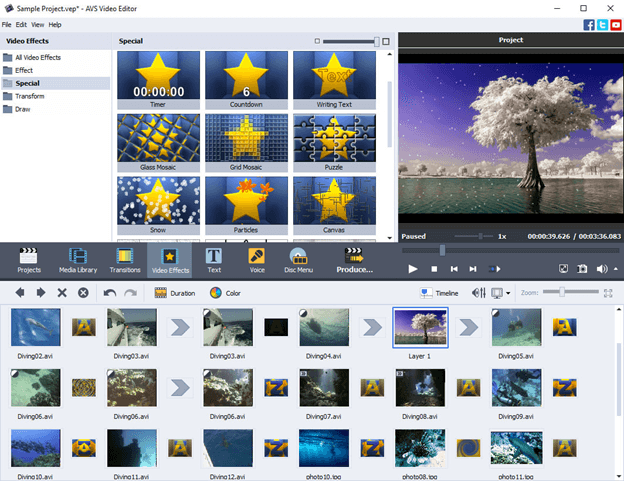
In addition to the above features, AVS Video Editor has a wide variety of patterns, stickers, emoji, arrows, and many others: *150+ supported formats *300+ visual effects and transitions *Colour balance fine-tuning *Video stabilization of shaky recordings *Chromakey *Playback Control (slow-mo and fast mo) *A wide variety of text styles, animated captions, speech bubbles, and credits *A rich collection of patterns. Publish your video in social media sites, burn a DVD/Blu-ray disc, or save your video in the format of your choice on your computer.
In this article, we will review the AVS editor briefly
AVS Pros
- You can choose from more than 300 video effects, transitions, titles, and overlays.
- There are various features that make it easy for you to get the perfect results for your videos, such as the ability to flick through shots in your timeline without pausing.
- Based on your skill level, you can choose between two modes: Basic or Advanced.
- If you want to change the pace of your videos while maintaining their quality, you can use the video speed control.
How To Use AVS Video Editor?
As soon as you have downloaded and installed the software, follow the instructions. The first time you boot up your computer after installing the software, you will see a popup for quick start instructions. It would be a great place to start someday, even if you skip it for now. For an in-depth guide on how to use the software, we recommend watching the videos.
If you open AVS Video Editor for the first time, you’ll notice that it shares many features with other editing software. Files can be dragged and dropped directly into the program or imported from other sources, such as your desktop or cloud storage. The camera can also capture media directly from the clipboard and even the desktop screen can be captured.
The timeline displays several buttons for different functions once the media is loaded. A clip can be trimmed, enhanced with a filter, and text or music can be added.
You can add a variety of effects to your videos using AVS Video Editor, which makes it stand out from other video editing software. There are thousands of preset transitions and visual filters available for use within the program once you’ve opened a clip. Audio and brightness adjustments can also be made.
Other video editing software does not offer the same features as this one. AVS Video Editor, for example, allows you to add watermarks and overlays to videos without any lag time or loss in quality, which would be impossible with other programs.
The animated logos and text in the video are another great feature. Adding an intro or outro to the end of your video will give it that professional touch before you publish it on YouTube.
AVS VIDEO EDITOR – FEATURES
Video management of different formats
All major formats are supported. Video files such as AVI, VOB, MP4, DVD, WMV, 3GP, MOV, MKV can be processed and saved using , MPEG-4, H.263, etc. codecs. With DCI 4K, you can manage HD, Full HD, 2K Quad HD, 4K Ultra HD, and 4K Ultra HD.
Edit video
From a library of 300 video effects and transitions, you can cut, split, merge, rotate, and mix your video. Subtitles, audio, and comments are also supported. Stabilize flickering videos.
Acceleration of HD video editing
HD video processing becomes faster with AVI HD, WMV HD, TOD, AVCHD, MOD, MTS, and M2TS thanks to integrated video caching technology.
Video capture
DV/HDV/web camcorders and DVD burners can transfer video from these devices. Create video guides, presentations, or demos by recording multimedia files from the PC screen.
Creating Blu-Ray videos
Blu-ray Editor lets you edit your videos by applying various effects and adding descriptions, audio, video, and images.
Video sharing:
Your video can be saved on the computer, burned on a DVD / Blu-ray disc, adjusted for mobile devices (iOS, Android), or shared on social networks (Facebook, Youtube).
Final Verdict About AVS Video Editor
The software is very easy to use and includes a complete library of effects, transitions, menus, and subtitle elements that can be customized to suit any user’s needs. It is complete and very appealing for beginners just getting started with video editing as it allows you to burn to DVD or Blu-ray and post directly on social media.
Our Recommendation
While it is a great tool for beginners, it is outdated and behind modern-day video editors if you compare it with them. As a result, you need a video editor with plenty of powerful features and one that is competitive with the marketplace today. We recommended using our Filmora X video editor. Now it is user-friendly but also suitable for beginners. It contains all the features you need today to put life in your videos. It’s free to try for as long as you want, which is the main advantage here. So what are you waiting for? Try it out today, and you’ll enjoy editing videos.
For Win 7 or later (64-bit)
For macOS 10.12 or later
In addition to the above features, AVS Video Editor has a wide variety of patterns, stickers, emoji, arrows, and many others: *150+ supported formats *300+ visual effects and transitions *Colour balance fine-tuning *Video stabilization of shaky recordings *Chromakey *Playback Control (slow-mo and fast mo) *A wide variety of text styles, animated captions, speech bubbles, and credits *A rich collection of patterns. Publish your video in social media sites, burn a DVD/Blu-ray disc, or save your video in the format of your choice on your computer.
In this article, we will review the AVS editor briefly
AVS Pros
- You can choose from more than 300 video effects, transitions, titles, and overlays.
- There are various features that make it easy for you to get the perfect results for your videos, such as the ability to flick through shots in your timeline without pausing.
- Based on your skill level, you can choose between two modes: Basic or Advanced.
- If you want to change the pace of your videos while maintaining their quality, you can use the video speed control.
How To Use AVS Video Editor?
As soon as you have downloaded and installed the software, follow the instructions. The first time you boot up your computer after installing the software, you will see a popup for quick start instructions. It would be a great place to start someday, even if you skip it for now. For an in-depth guide on how to use the software, we recommend watching the videos.
If you open AVS Video Editor for the first time, you’ll notice that it shares many features with other editing software. Files can be dragged and dropped directly into the program or imported from other sources, such as your desktop or cloud storage. The camera can also capture media directly from the clipboard and even the desktop screen can be captured.
The timeline displays several buttons for different functions once the media is loaded. A clip can be trimmed, enhanced with a filter, and text or music can be added.
You can add a variety of effects to your videos using AVS Video Editor, which makes it stand out from other video editing software. There are thousands of preset transitions and visual filters available for use within the program once you’ve opened a clip. Audio and brightness adjustments can also be made.
Other video editing software does not offer the same features as this one. AVS Video Editor, for example, allows you to add watermarks and overlays to videos without any lag time or loss in quality, which would be impossible with other programs.
The animated logos and text in the video are another great feature. Adding an intro or outro to the end of your video will give it that professional touch before you publish it on YouTube.
AVS VIDEO EDITOR – FEATURES
Video management of different formats
All major formats are supported. Video files such as AVI, VOB, MP4, DVD, WMV, 3GP, MOV, MKV can be processed and saved using , MPEG-4, H.263, etc. codecs. With DCI 4K, you can manage HD, Full HD, 2K Quad HD, 4K Ultra HD, and 4K Ultra HD.
Edit video
From a library of 300 video effects and transitions, you can cut, split, merge, rotate, and mix your video. Subtitles, audio, and comments are also supported. Stabilize flickering videos.
Acceleration of HD video editing
HD video processing becomes faster with AVI HD, WMV HD, TOD, AVCHD, MOD, MTS, and M2TS thanks to integrated video caching technology.
Video capture
DV/HDV/web camcorders and DVD burners can transfer video from these devices. Create video guides, presentations, or demos by recording multimedia files from the PC screen.
Creating Blu-Ray videos
Blu-ray Editor lets you edit your videos by applying various effects and adding descriptions, audio, video, and images.
Video sharing:
Your video can be saved on the computer, burned on a DVD / Blu-ray disc, adjusted for mobile devices (iOS, Android), or shared on social networks (Facebook, Youtube).
Final Verdict About AVS Video Editor
The software is very easy to use and includes a complete library of effects, transitions, menus, and subtitle elements that can be customized to suit any user’s needs. It is complete and very appealing for beginners just getting started with video editing as it allows you to burn to DVD or Blu-ray and post directly on social media.
Our Recommendation
While it is a great tool for beginners, it is outdated and behind modern-day video editors if you compare it with them. As a result, you need a video editor with plenty of powerful features and one that is competitive with the marketplace today. We recommended using our Filmora X video editor. Now it is user-friendly but also suitable for beginners. It contains all the features you need today to put life in your videos. It’s free to try for as long as you want, which is the main advantage here. So what are you waiting for? Try it out today, and you’ll enjoy editing videos.
For Win 7 or later (64-bit)
For macOS 10.12 or later
In addition to the above features, AVS Video Editor has a wide variety of patterns, stickers, emoji, arrows, and many others: *150+ supported formats *300+ visual effects and transitions *Colour balance fine-tuning *Video stabilization of shaky recordings *Chromakey *Playback Control (slow-mo and fast mo) *A wide variety of text styles, animated captions, speech bubbles, and credits *A rich collection of patterns. Publish your video in social media sites, burn a DVD/Blu-ray disc, or save your video in the format of your choice on your computer.
In this article, we will review the AVS editor briefly
AVS Pros
- You can choose from more than 300 video effects, transitions, titles, and overlays.
- There are various features that make it easy for you to get the perfect results for your videos, such as the ability to flick through shots in your timeline without pausing.
- Based on your skill level, you can choose between two modes: Basic or Advanced.
- If you want to change the pace of your videos while maintaining their quality, you can use the video speed control.
How To Use AVS Video Editor?
As soon as you have downloaded and installed the software, follow the instructions. The first time you boot up your computer after installing the software, you will see a popup for quick start instructions. It would be a great place to start someday, even if you skip it for now. For an in-depth guide on how to use the software, we recommend watching the videos.
If you open AVS Video Editor for the first time, you’ll notice that it shares many features with other editing software. Files can be dragged and dropped directly into the program or imported from other sources, such as your desktop or cloud storage. The camera can also capture media directly from the clipboard and even the desktop screen can be captured.
The timeline displays several buttons for different functions once the media is loaded. A clip can be trimmed, enhanced with a filter, and text or music can be added.
You can add a variety of effects to your videos using AVS Video Editor, which makes it stand out from other video editing software. There are thousands of preset transitions and visual filters available for use within the program once you’ve opened a clip. Audio and brightness adjustments can also be made.
Other video editing software does not offer the same features as this one. AVS Video Editor, for example, allows you to add watermarks and overlays to videos without any lag time or loss in quality, which would be impossible with other programs.
The animated logos and text in the video are another great feature. Adding an intro or outro to the end of your video will give it that professional touch before you publish it on YouTube.
AVS VIDEO EDITOR – FEATURES
Video management of different formats
All major formats are supported. Video files such as AVI, VOB, MP4, DVD, WMV, 3GP, MOV, MKV can be processed and saved using , MPEG-4, H.263, etc. codecs. With DCI 4K, you can manage HD, Full HD, 2K Quad HD, 4K Ultra HD, and 4K Ultra HD.
Edit video
From a library of 300 video effects and transitions, you can cut, split, merge, rotate, and mix your video. Subtitles, audio, and comments are also supported. Stabilize flickering videos.
Acceleration of HD video editing
HD video processing becomes faster with AVI HD, WMV HD, TOD, AVCHD, MOD, MTS, and M2TS thanks to integrated video caching technology.
Video capture
DV/HDV/web camcorders and DVD burners can transfer video from these devices. Create video guides, presentations, or demos by recording multimedia files from the PC screen.
Creating Blu-Ray videos
Blu-ray Editor lets you edit your videos by applying various effects and adding descriptions, audio, video, and images.
Video sharing:
Your video can be saved on the computer, burned on a DVD / Blu-ray disc, adjusted for mobile devices (iOS, Android), or shared on social networks (Facebook, Youtube).
Final Verdict About AVS Video Editor
The software is very easy to use and includes a complete library of effects, transitions, menus, and subtitle elements that can be customized to suit any user’s needs. It is complete and very appealing for beginners just getting started with video editing as it allows you to burn to DVD or Blu-ray and post directly on social media.
Our Recommendation
While it is a great tool for beginners, it is outdated and behind modern-day video editors if you compare it with them. As a result, you need a video editor with plenty of powerful features and one that is competitive with the marketplace today. We recommended using our Filmora X video editor. Now it is user-friendly but also suitable for beginners. It contains all the features you need today to put life in your videos. It’s free to try for as long as you want, which is the main advantage here. So what are you waiting for? Try it out today, and you’ll enjoy editing videos.
For Win 7 or later (64-bit)
For macOS 10.12 or later
In addition to the above features, AVS Video Editor has a wide variety of patterns, stickers, emoji, arrows, and many others: *150+ supported formats *300+ visual effects and transitions *Colour balance fine-tuning *Video stabilization of shaky recordings *Chromakey *Playback Control (slow-mo and fast mo) *A wide variety of text styles, animated captions, speech bubbles, and credits *A rich collection of patterns. Publish your video in social media sites, burn a DVD/Blu-ray disc, or save your video in the format of your choice on your computer.
In this article, we will review the AVS editor briefly
AVS Pros
- You can choose from more than 300 video effects, transitions, titles, and overlays.
- There are various features that make it easy for you to get the perfect results for your videos, such as the ability to flick through shots in your timeline without pausing.
- Based on your skill level, you can choose between two modes: Basic or Advanced.
- If you want to change the pace of your videos while maintaining their quality, you can use the video speed control.
How To Use AVS Video Editor?
As soon as you have downloaded and installed the software, follow the instructions. The first time you boot up your computer after installing the software, you will see a popup for quick start instructions. It would be a great place to start someday, even if you skip it for now. For an in-depth guide on how to use the software, we recommend watching the videos.
If you open AVS Video Editor for the first time, you’ll notice that it shares many features with other editing software. Files can be dragged and dropped directly into the program or imported from other sources, such as your desktop or cloud storage. The camera can also capture media directly from the clipboard and even the desktop screen can be captured.
The timeline displays several buttons for different functions once the media is loaded. A clip can be trimmed, enhanced with a filter, and text or music can be added.
You can add a variety of effects to your videos using AVS Video Editor, which makes it stand out from other video editing software. There are thousands of preset transitions and visual filters available for use within the program once you’ve opened a clip. Audio and brightness adjustments can also be made.
Other video editing software does not offer the same features as this one. AVS Video Editor, for example, allows you to add watermarks and overlays to videos without any lag time or loss in quality, which would be impossible with other programs.
The animated logos and text in the video are another great feature. Adding an intro or outro to the end of your video will give it that professional touch before you publish it on YouTube.
AVS VIDEO EDITOR – FEATURES
Video management of different formats
All major formats are supported. Video files such as AVI, VOB, MP4, DVD, WMV, 3GP, MOV, MKV can be processed and saved using , MPEG-4, H.263, etc. codecs. With DCI 4K, you can manage HD, Full HD, 2K Quad HD, 4K Ultra HD, and 4K Ultra HD.
Edit video
From a library of 300 video effects and transitions, you can cut, split, merge, rotate, and mix your video. Subtitles, audio, and comments are also supported. Stabilize flickering videos.
Acceleration of HD video editing
HD video processing becomes faster with AVI HD, WMV HD, TOD, AVCHD, MOD, MTS, and M2TS thanks to integrated video caching technology.
Video capture
DV/HDV/web camcorders and DVD burners can transfer video from these devices. Create video guides, presentations, or demos by recording multimedia files from the PC screen.
Creating Blu-Ray videos
Blu-ray Editor lets you edit your videos by applying various effects and adding descriptions, audio, video, and images.
Video sharing:
Your video can be saved on the computer, burned on a DVD / Blu-ray disc, adjusted for mobile devices (iOS, Android), or shared on social networks (Facebook, Youtube).
Final Verdict About AVS Video Editor
The software is very easy to use and includes a complete library of effects, transitions, menus, and subtitle elements that can be customized to suit any user’s needs. It is complete and very appealing for beginners just getting started with video editing as it allows you to burn to DVD or Blu-ray and post directly on social media.
Our Recommendation
While it is a great tool for beginners, it is outdated and behind modern-day video editors if you compare it with them. As a result, you need a video editor with plenty of powerful features and one that is competitive with the marketplace today. We recommended using our Filmora X video editor. Now it is user-friendly but also suitable for beginners. It contains all the features you need today to put life in your videos. It’s free to try for as long as you want, which is the main advantage here. So what are you waiting for? Try it out today, and you’ll enjoy editing videos.
For Win 7 or later (64-bit)
For macOS 10.12 or later
Also read:
- New Cartoonize Your Videos The Ultimate Conversion Tutorial for 2024
- Updated Mobile Animation Magic Top Stop Motion Apps Revealed
- Updated In 2024, Top 10 Free Video Stabilization Tools for Smooth Footage
- New 2024 Approved Premiere Pro Compatibility What You Need to Know About System Requirements
- Updated Breathtaking 4K Videos You Wont Want to Miss for 2024
- 2024 Approved PC Video Trimmer Showdown Top 10 Desktop and Online Options
- New Sync Like a Pro Audio and Video Alignment in FCPX 2024 Made Easy
- Transform Your GoPro Clips A Comprehensive Mac Editing Tutorial for 2024
- New In 2024, Join WMV Videos for Free Top 5 Tools
- New Unleash Your Potential Top Video Resume Creators with Free Templates and Tips
- New 2024 Approved Revolutionize Your Video Workflow Top Apple Editing Solutions
- New In 2024, The Ultimate Guide to Compressing Videos on iPhone and iPad for Free
- Updated 2024 Approved Saving Made Easy A Step-by-Step Final Cut Pro Guide
- Updated In 2024, Rotate Your Videos for Free Top Online Video Flip Tools
- New In 2024, Transform Your Photos Into Mesmerizing Music Videos with These Top Picks
- Updated 10 Free Video Surveillance Software Solutions to Keep You Safe for 2024
- Updated In 2024, Dailymotion Video Conversion Made Easy - Free Tool
- Updated 2024 Approved Compress MPEG2 Videos with Free VirtualDub Software
- New You Dont Need Professional Camera Equipment if You Want to Create Time-Lapse Videos You Can Share on Your Social Media Accounts because There Are Plenty of Apps that Let You Create These Types of Vid for 2024
- Updated In 2024, Create Stunning Lyric Videos with These Online Tools Free & Paid
- New In 2024, The Best of the Rest 10 Final Cut Pro X Alternatives for Video Editors
- New 2024 Approved Windows 8 FLV Video Editor Simplify Your Editing Process
- The Ultimate List 28 Top-Rated Video to GIF Converters for 2024
- Updated 2024 Approved Start Recording Your Games Today 3 Easy Steps
- New The Funniest in the Business 5 Reaction Video Makers Youll Love for 2024
- Updated 2024 Approved Updated The Top 10 Free and Paid 2D Animation Software You Need to Know
- In 2024, Speed Up or Slow Down Top GIF Editors Reviewed
- New 2024 Approved Edit MOV Files for Free Top 10 Video Editing Software
- Updated From Novice to Pro 3 Easy Game Recording Options for 2024
- New In 2024, Facebook Video Aspect Ratios Demystified A Complete Guide
- Updated 2024 Approved Discover the Best YouTube MP3 Converters for Your Needs
- Updated Unleash Your Creativity Video Editing Tips for Family Filmmakers
- New 2024 Approved Design to Convert YouTube Thumbnail Size Guidelines and Effective Strategies
- 2024 Approved Wav Conversion Made Easy A Beginners Blueprint
- In 2024, The Ultimate Virtualdub Alternative Guide Features and Pricing
- New Effortless Video Editing Best Alternatives to Traditional Joiners for 2024
- Updated Top 6 Darth Vader AI Generators for All Platforms
- Updated Android Video Editing Essentials 10 Must-Have Apps
- How To Change Your SIM PIN Code on Your Vivo Y56 5G Phone
- Detailed guide of ispoofer for pogo installation On Nokia C32 | Dr.fone
- In 2024, Full Guide to Fix iToolab AnyGO Not Working On OnePlus 11 5G | Dr.fone
- In 2024, Detailed guide of ispoofer for pogo installation On Samsung Galaxy F04 | Dr.fone
- In 2024, Recommended Best Applications for Mirroring Your Honor X7b Screen | Dr.fone
- Updated Effortless 4K Video Editing Top Proxy Editing Apps for Creators
- What to Do if Google Play Services Keeps Stopping on Realme C51 | Dr.fone
- The Ultimate Guide to Get the Rare Candy on Pokemon Go Fire Red On Nokia C12 Pro | Dr.fone
- In 2024, Simple and Effective Ways to Change Your Country on YouTube App Of your Samsung Galaxy A05s | Dr.fone
- Google Play Services Wont Update? 12 Fixes are Here on Nokia C32 | Dr.fone
- How to Transfer Data from Nubia Red Magic 9 Pro+ to Any iOS Devices | Dr.fone
- In 2024, Ways To Find Unlocking Codes For Vivo V29 Pro Phones
- Lava Yuva 2 Pro Bootloop Problem, How to Fix it Without Data Loss | Dr.fone
- Updated Have You Ever Wondered How to Add Camera Shake to Video in Adobe After Effects? Let Us Share with You some Tips and Tricks on How to Do Just That
- How to Detect and Remove Spyware on Vivo X90S? | Dr.fone
- In 2024, Everything To Know About Apple ID Password Requirements For iPhone 11 Pro
- In 2024, Additional Tips About Sinnoh Stone For Samsung Galaxy S24 | Dr.fone
- 4 solution to get rid of pokemon fail to detect location On Oppo Find X7 Ultra | Dr.fone
- 7 Fixes for Unfortunately, Phone Has Stopped on Asus ROG Phone 8 Pro | Dr.fone
- How To Open Your iPhone 15 Without a Home Button | Dr.fone
- In 2024, How to Intercept Text Messages on Xiaomi Redmi A2 | Dr.fone
- Vivo S18 Bootloop Problem, How to Fix it Without Data Loss | Dr.fone
- In 2024, How Do I Stop Someone From Tracking My HTC U23 Pro? | Dr.fone
- How to Track Vivo Y27 4G by Phone Number | Dr.fone
- In 2024, Slow and Steady Wins Free Slow Motion Video Editing with Filmora
- In 2024, Top IMEI Unlokers for Your Oppo Reno 10 Pro 5G Phone
- In 2024, Hassle-Free Ways to Remove FRP Lock on Xiaomi 14 Ultrawith/without a PC
- Title: New 2024 Approved Life After Windows Movie Maker Exploring New Options
- Author: Ava
- Created at : 2024-04-29 13:18:20
- Updated at : 2024-04-30 13:18:20
- Link: https://video-content-creator.techidaily.com/new-2024-approved-life-after-windows-movie-maker-exploring-new-options/
- License: This work is licensed under CC BY-NC-SA 4.0.

